2. The Place
© 2022 William St Clair, CC BY-NC-ND 4.0 https://doi.org/10.11647/OBP.0136.02
Ottoman Athens
Before the Revolution, the town of Athens was clustered round the north and north-eastern slopes of the Acropolis, as shown in Figure 2.1.
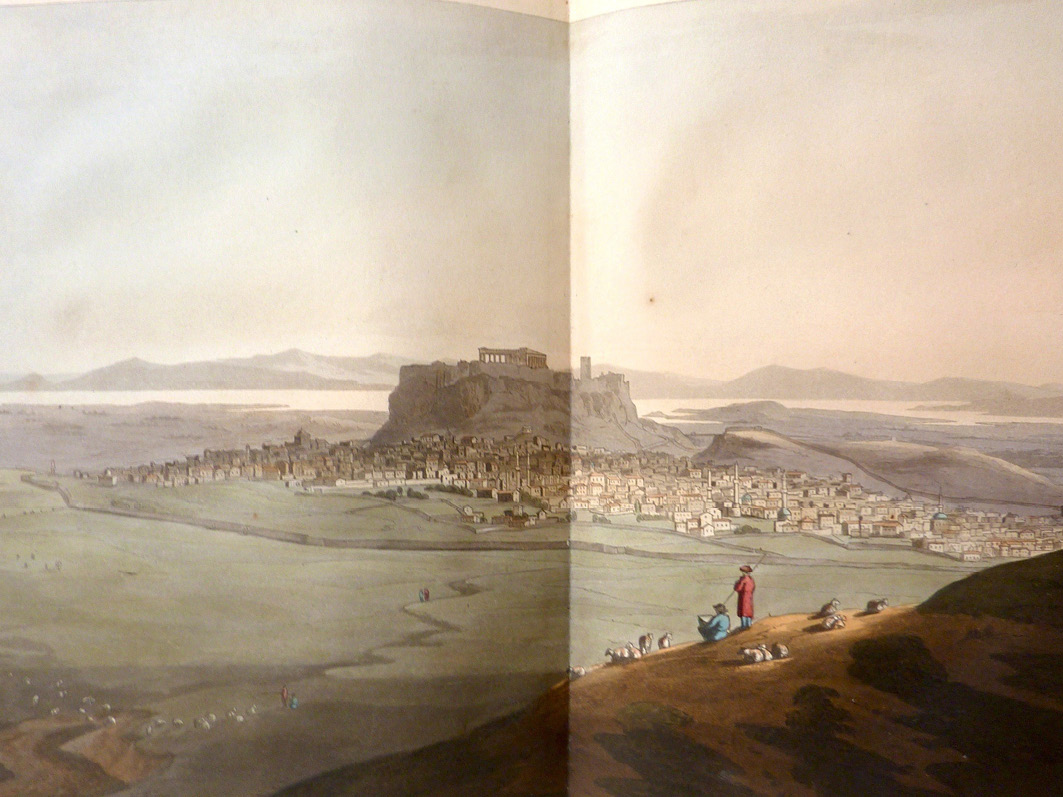
Figure 2.1. ‘Athens from the foot of Mt Anchesmus’ (ancient and modern Lycavettos). Coloured aquatint, from a view made on the spot, c.1810.1
During the hot summer months, the Acropolis appeared as a grey rock, standing among its olive groves and fruit orchards in a brown, dusty, landscape. According to a visitor in 1819, the oil that was destined for export was carried in goatskins, specially made, in which the head of the animal was cut off but the neck and front legs remained, so that they could be strapped to the sides of donkeys, a more effective and economical means of transport, especially by land, than the heavy amphorae found in ancient shipwrecks, and one that may have been used in ancient times but has left no trace in the archaeological or literary record.2
The town was not visible from ships at sea. It was because many mariners from western countries saw the Acropolis but not the town that a story had taken root in western countries that Athens, like Troy, had ceased to exist. Athens had, some apparently authoritative printed works reported, been destroyed by the Turks, an error prolonged by the business practices of the printed book industry that encouraged the copyright holders of the printers’ guilds to reprint old texts long after they had been factually superseded.3 William Lithgow, for example, who visited Athens in 1609, felt the need to assure the readers of his book that ‘Athens is still inhabited.’4
The Acropolis physically dominated the cityscape and the surrounding landscape as far as the eye could see in all directions, as it had done since ancient times. Surrounded by steep cliffs and walls on three sides, the single entrance to the Acropolis was on the west side and although built for an era long before gunpowder, in the eighteenth century it was still formidable. Since almost all the military works and walls round which the fighting occurred during the Greek Revolution were removed in the nineteenth century, we are now mostly dependent on written historical accounts and on pictures made before the removals.5 The picture shown as Figure 2.2, for example, made shortly before the Revolution, shows how a complex of walls and outworks offered a sense of impregnability.
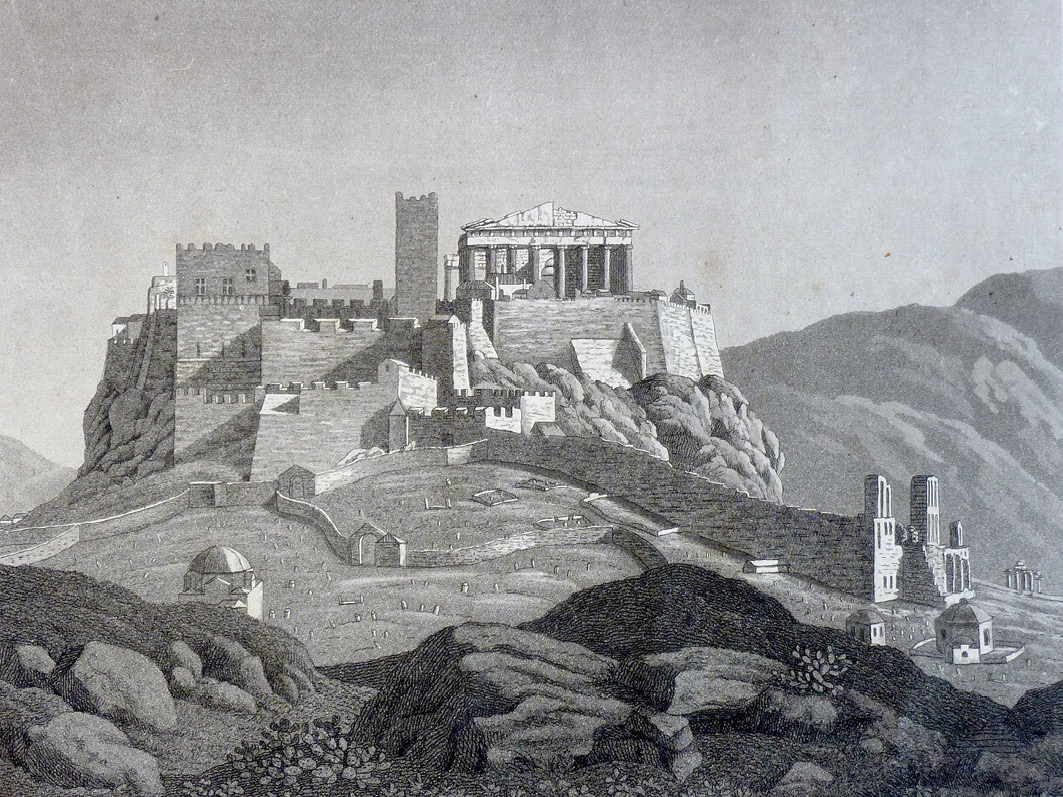
Figure 2.2. The Acropolis of Athens from the west, by Heinrich Hübsch, 1819. Tinted aquatint published in Denmark with commentary in Danish.6
The castellations on the ancient walls gave it a western European appearance, like many of the Crusader Castles of the Levant and the Middle East, a fortress implanted into the landscape not for the defence of the local population but as a means of domination.7 The castellations had mostly been added by the Frankish princes who took control of Athens from the local Byzantine archbishop as part of the spoils after the Fourth Crusade destroyed Constantinople/Byzantium in 1204, and by their successors.8 They were to be used in the Revolution, both as firing and as lookout points, but were taken down soon afterwards as part of the Hellenizing of the view.9 Visible on the left of the image is the tall structure, now known as the Frankish Tower, that had been built at some time, now thought to be during the thirteenth or fourteenth centuries, to give the defenders of the Acropolis a longer view and therefore more notice of impending danger than was available from standing on the tops of the ancient buildings. It was to be removed after 1874 as part of the transformation of the Acropolis from military fortress to heritage site.10 This image, taken with that shown as Figure 2.1, and many others, reminds us that in antiquity, as in the long eighteenth century, the Parthenon was not visible from the parts of the town where most daily life took place. It could be seen from far away, both locally in Attica and from other acropolises, notably that of Corinth, from the temple on the heights of Aegina, and from far out to sea. But it was only visible from close up to those who were able to visit the Acropolis. In ancient times, this occurred mainly when they were participating in festivals.11
It appears to have been as recently as 1805 that the Ottoman authorities completed the defensive works on the walls and the ground level outworks that had been made necessary by their experience of the temporary loss of the Acropolis to a western army led by General Francesco Morosini, in 1687–1688.12 A marble inscription in Ottoman Turkish claiming the credit for Mustapha Effendi was identified in 1924 as having been carved on a slab that had once been part of the Erechtheion architrave.13 Another Ottoman inscription that declared that the Giaours, that is, the Christians, would never again possess the Acropolis was set above the outermost of the three gates on the road from the town. I only know of it because it is mentioned by an American linguist, Henry M. Baird, who spent a year in Athens in the 1850s, travelling with a Turkish interpreter.14 In the eighteenth century the Muslim population of Athens and elsewhere in Greece spoke Greek as their first language, and few would have been able to read it.15 Although these public inscriptions were designed, composed, and placed with the specific intention of influencing every visitor to the Acropolis, they had little power to prime the minds of viewers, either local or visiting. They were still there, being seen but not viewed, mute stones with no-one to voice them, long after the other more conspicuously visual markers of the former Muslim presence, such as the minarets of the mosques and the gravestones in the Muslim cemetery, had been destroyed or removed.16
Figure 2.3 shows the entrance to the Acropolis on the eve of the Revolution.
The picture shows the then disdar (military commander of the Acropolis), accompanied by a holy man (‘dervish’) and a servant. As can be seen within the image, a number of small artillery pieces were mounted on the walls. Another gun is recorded as placed on the wall overlooking the Serpenji where the main water cistern was located, making altogether ‘four miserable guns’ in the phrase of a visitor in May 1812.17 However, on the eve of the Revolution, any hostile force approaching along the paved way to the main entrance gate could have been stopped by a single piece of ordnance and a few men with muskets or swords. The glimpse of the Frankish Tower shows one of its roles, as a prison with a grilled window. And the figure carrying a jar, perhaps a slave, reminds us of how dependent the Acropolis was on supplies brought from outside with the help of human and animal power. The drinking water was taken up daily in earthenware jars strapped to horses and donkeys.18
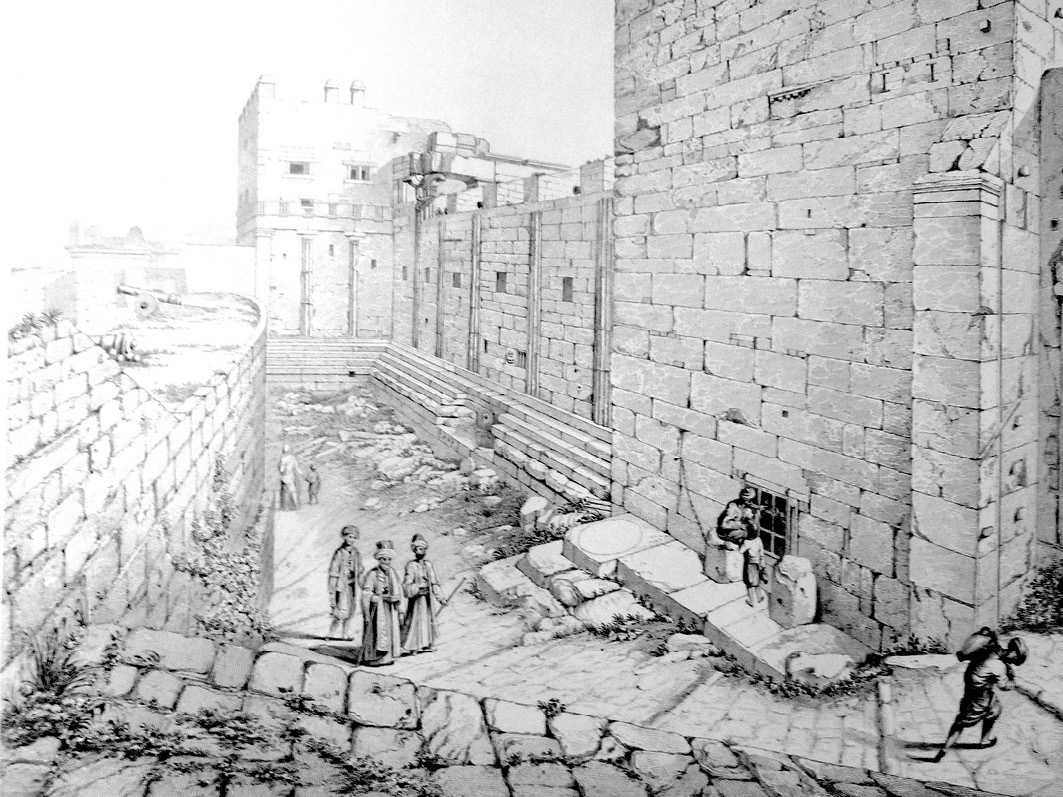
Figure 2.3. ‘View of the West front of the Propylaia at Athens’. Copper engraving. Published in 1830 from a drawing made in 1818 by the architect William Kinnard.19
It may not always have been so. Evliya Çelebi, author of a long book of observations of the Ottoman Empire, known as Seyahatname, who visited in 1667, twenty years before the Parthenon was damaged, noted that: ‘when rain falls on these marble roof-tiles [of the Parthenon], it runs off by cunningly incised channels into a cistern […] so there is plenty of fresh cold water for the thirsty congregation.’20 Other eyewitnesses also record seeing the marble plates, although among those accounts that are at present known, only Evliya mentions the purpose of collecting rainwater.21 Although, as has been remarked by a modern editor, Evliya had a ‘vivid and colourful imagination’, and is recorded as suggesting, for example, that the Bosphorus was a canal built by Alexander of Macedon to connect the Black Sea with the Mediterranean, he had on his extensive travels visited seven thousand Ottoman fortresses and taken part in many campaigns. He may therefore have been more aware of the military importance of access to water than the local authors and western topographers who recorded what they saw in Athens before 1687, and understood that marble plates would enable water to be collected.22 If the commissioners, architects, and builders of the classical Parthenon had found ways, however expensive, of making the Acropolis more self-sufficient in water than it had previously been, they had gone far to cure a weakness that had caused the fortress to be captured more than once in what to them were earlier years. In ancient times an acropolis without water was almost a contradiction, like an acropolis without walls, scarcely an acropolis at all. We may also have here a contribution towards an answer to a question that has seldom been asked in modern times. Why did the builders of the classical Parthenon choose to flaunt a story of the lack of potable water on the Acropolis on the most visible of all the stories in stone presented on the building, the west pediment?23
During the Ottoman centuries when the Acropolis was home to Ottoman soldiers and their families the non-potable water that was available at some times of year on the summit probably provided the place for the ritual washing that was required of Muslims before taking part in the rituals in the mosque. The non-potable water also seems to have supplied a cesspool on the north slope where archaeologists in the 1930s found over 1,500 Ottoman era coins, each a misfortune for somebody who had taken down his or her baggy trousers at the allotted place.24
Haseki’s Wall and Siege Warfare
In 1778 the local authorities of Athens decided that the town needed greater protection against the increasing raids by marauders arriving by land or sea. Haseki’s wall, as it was called locally from the name of the Ottoman governor (voivode) then in power,25 was thus hurriedly erected. This fortification was nearly four English miles in circumference, eight feet high, and included six gates that were normally left open even at night. About twenty towers, mainly made of wood, set at intervals within shouting distance of one another, were about twice the height of the wall.26 In times of danger, they could be climbed with ladders and be used as viewing stations from which to look outwards in all directions. If an attempt at an incursion seemed imminent, the towers could be employed as command centres from which operations could be directed by, for example, rushing men to the threatened sections of the wall and mobilizing women and others to carry baskets of débris with which to fill in any breaches. For the few local inhabitants, almost all Muslims, who were legally permitted to have firearms, or to whom firearms could be issued in an emergency, enfilade fire could prevent marauders from approaching. And, even if some managed to enter the town by breaching the wall, if the townspeople held together, it was impossible for them to get out again, let alone to carry away any booty they may have seized, whether provisions, weapons, or persons. In some places the wall was set forward from the built-up area, leaving open spaces available for the cultivation of crops and the grazing of animals, and so providing a measure of food security in case the town was cut off.27 According to a British army officer who visited Athens a few years after the wall was completed, it was intended to defend the town ‘from the irruptions of the Albanians, who are ever ready for a revolt, and have several times plundered the town.’28
Haseki’s wall, built by forced labour, was adequate in a situation where the only weapons available to marauders were swords, daggers, pikes, and a few muskets. Walls of this kind, which accorded with a standard Ottoman pattern, were a cheap way of improving internal security in the provinces of the Ottoman Empire where lawlessness was endemic. Against armies, Haseki’s wall was less effective. Unsubstantial though it was, however, a few defenders could still prevent any breaches from being exploited at least for a while. When the Ottoman army under the command of Reschid Mehmed Pasha (Reşid Mehmed Pasha), the Seraskier (Ottoman military commander) often known in Greece as Kiutahi from the place of his birth in Asia, arrived outside Athens in 1826, it took thirty-four days during which the wall was bombarded with artillery by day, making breaches that the defenders filled in by night, before the town was eventually captured.29
This form of slow siege warfare was not much different from the practice of western European armies in western Europe during the early modern period, for example, in the sieges of towns in the Netherlands by Spanish armies. Success was normally as much a matter of the length of a time a blockade could be sustained as of military strength and fighting ability, a trial of the logistics as much as of weaponry and trained manpower. Success was dependent too on access to food and fodder for the haulage animals, as well as to drinking water, to firewood, and on taking measures to contain the risks of epidemic illnesses to which all sides in a conflict were often exposed.
In the spring of 1818, just three years before the outbreak of the Greek Revolution, there was earth heaped against Haseki’s wall at various places to help people scramble across, as well as ‘a large hole … through which a short man might walk upright.’ When, in that year, news arrived that a plague was raging in Thebes to the north and later in Megara to the west, the voivode refused repeated requests from the populace and the foreign consuls to shut the gates, close the gaps, and to post guards. When the death rate rose to eighty a month, and the situation presented itself as a choice between maintaining the economy or reducing the expected mortality level, the voivode declared that anyone who set up a guard at the town gates would be shot and that any shopkeeper who closed his shop would be bastinadoed. Only after the epidemic had been experienced for over a year, and following an intervention by the voivode of Negropont in whose jurisdiction Athens lay, guards were posted at the gates of Athens to turn away visitors from the infected areas, although western visitors were exempted.30
In some places Haseki’s wall followed the course of earlier walls, with the builders making use of any materials that lay to hand, including pieces of ancient carved marble.31 In the early 1830s when de facto independence had been secured, the wall was soon being despoiled of the cut marble and dressed stones that were useful for the rebuilding of the town. By June 1834, just over a year after the last Ottoman soldiers left, the wall had ceased to exist.32 Occasional survivals, found in later archaeological excavations, such as that shown in Figure 2.4, confirm how insubstantial it had been.
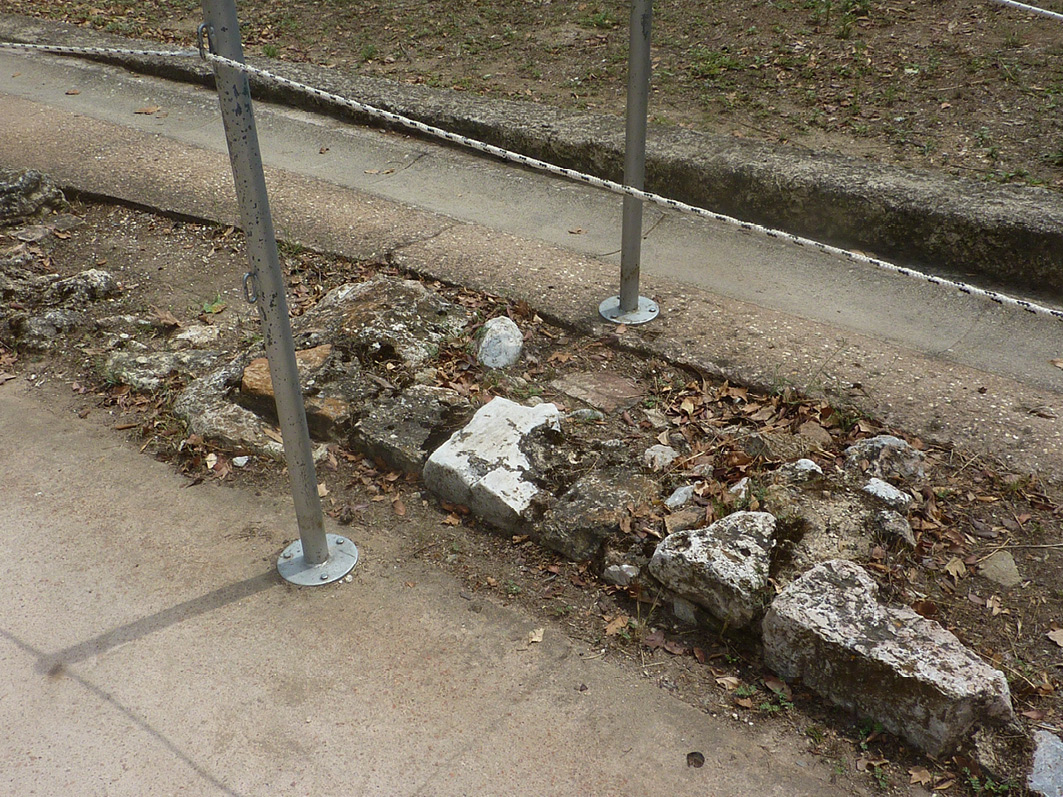
Figure 2.4. Remains of Haseki’s wall, south slope of the Acropolis. Author’s photograph, 2018. CC BY.
What may be other remains of the wall can be seen near the entrance to the Acropolis as shown in Figure 2.5, although they may have been built later to prevent stones from being taken for reuse locally or, in the case of choice pieces of marble, for sale to foreign collectors and local agents.
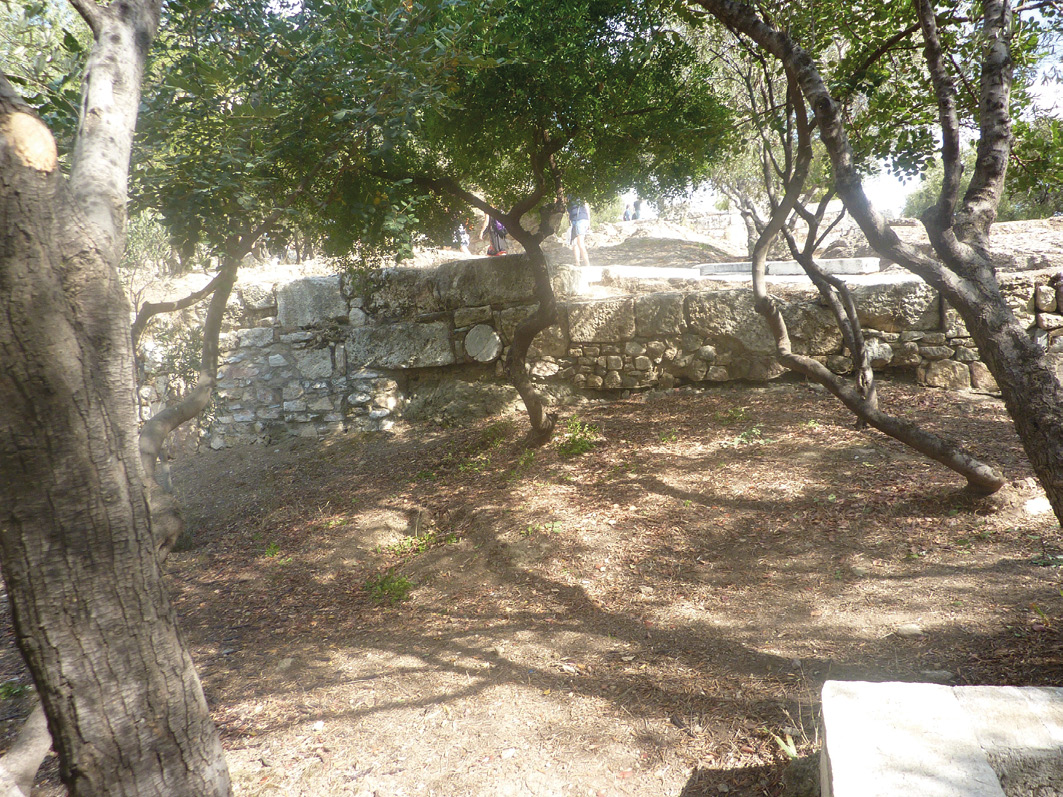
Figure 2.5. Possible remains of Haseki’s wall. Author’s photograph, 2014. CC BY.
Athens and its Fortifications at the Time of the Revolution
During most periods in its history, Athens had been vulnerable both to sea pirates landing on the Attic coast and to bandits arriving by land. On the many occasions when the town had been threatened, some inhabitants had sought refuge in the Acropolis, but others had gone to the island of Salamis or to the caves in the mountains nearby in hope of sitting out the crisis. Lookouts on the Parthenon could see possible invaders before they reached the town from any direction, but could also see the places to which the people, when they had warning, had been able to flee.33 Thucydides in the fifth century BCE had speculated that it was because the Acropolis lay a few miles inland that it had been chosen for human colonization at some remote age, a suggestion that archaeological findings from Neolithic times have tended to confirm.34 At the time of the Greek Revolution, the local geography and the local micro-climate still imposed many of the same limitations, and offered some of the same opportunities, of ancient times.35
Haseki’s wall incorporated Hadrian’s Gate, one of the ancient monuments of Athens that were architecturally largely unchanged since they were first built. A door was fitted and there was a platform for a lookout guard. A watercolour, initialled ‘A.M. 1821’, the year of the outbreak of the Revolution, made by an unidentified amateur British artist, is reproduced as Figure 2.6.
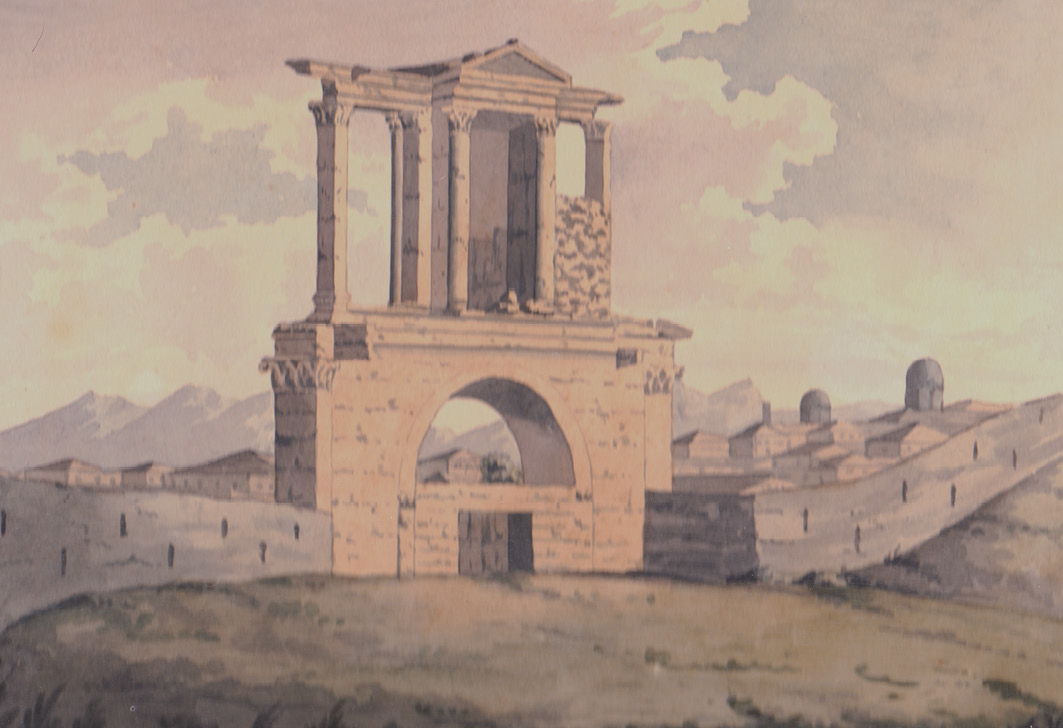
Figure 2.6. Hadrian’s Gate, 1821. Amateur watercolour.36
During a war in 1808 between the Ottoman Empire and Russia, when Hadrian’s Gate was closed at night, a resident of Athens who found the door shut simply kicked it down.37 In 1824, when Athens was temporarily in the hands of the Greek Revolutionary forces, the wall was sketched from a distance by another amateur, Archibald Black, a British naval surgeon, as shown as Figure 2.7.
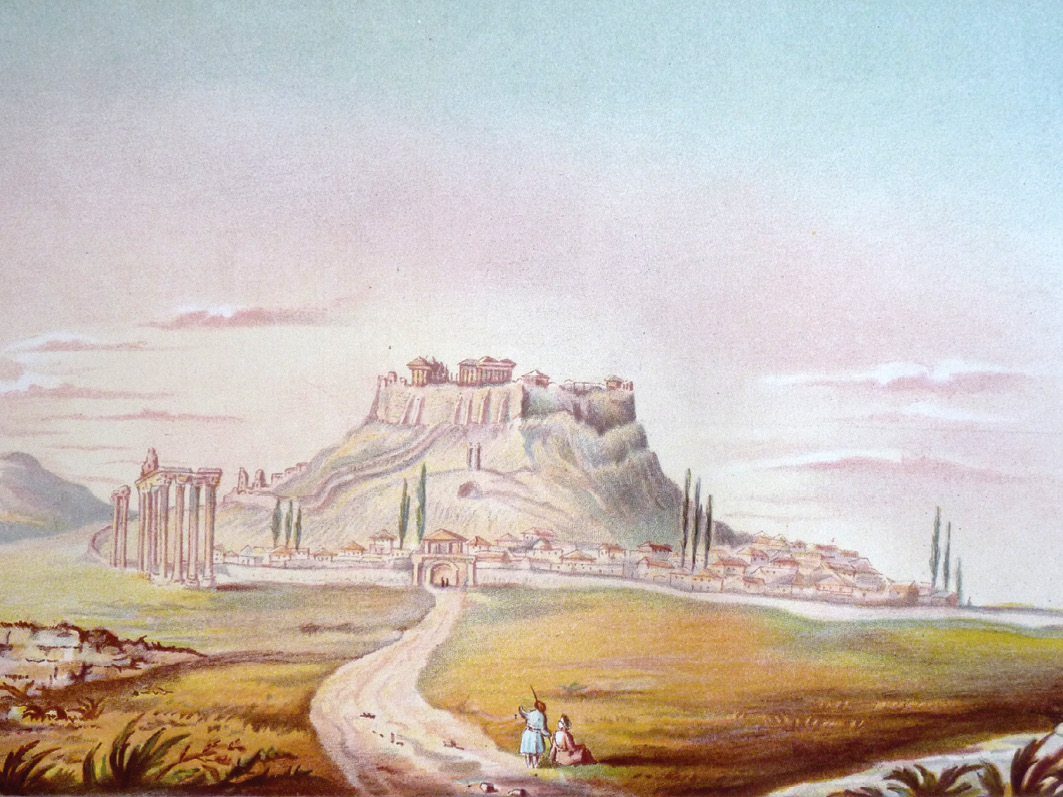
Figure 2.7. ‘View of the Acropolis from the banks of the Illysus, Sepr 1824’. Chromolithograph from a contemporary amateur picture.38
This image brings out the military importance of another wall that ran up the Acropolis on the south slope, enclosing the area occupied by the ruins of the Odeon of Herodes Atticus, a site that had long been identified from remarks in ancient authors but had not yet been excavated. The ‘Serpenji’, as this enclosed area at the left of the picture was called, included wells from which poor-quality water could be extracted during some seasons of the year, plus a few cisterns, built centuries before, where the water could be stored. Enough vegetation grew in the Serpenji to enable animals to survive at least for a while.39 Also visible in this image are the two ancient columns that stand above the Monument of Thrassylos, and the caves below, all accessible on foot.40 During the Revolution, much of the fighting, including sorties, sapping and mining, and attempts to climb over the walls with ladders, as well as artillery bombardment, musketry, and hand-to-hand fighting with swords and daggers, was a struggle for control of this area of the Acropolis slopes.
Pictures made on the spot by amateurs sometimes record features that professional stay-at-home artists, trained in the conventions of the western topographical and picturesque traditions, tended to omit. Much the actuality was also lost in the transfer from an on-the-spot sketch to a monochrome line engraving prepared by the skilled men and women who produced the final version that circulated most widely, and who had their own professional ideas of how ruins should be visually presented. Black’s picture, for example, presents the sky over Athens in a pale shade of violet. Whether knowingly or inadvertently, Black’s picture celebrated Athens as the ‘violet crowned’, a phrase that Pindar had popularized in his celebration of Athens in the fifth century BCE.41
Haseki’s wall enabled the authorities in Athens to monitor and to tax commercial traffic in and out.42 His many acts of arbitrary, unfair, and cruel government made him rich enough to buy the well-watered estate at Patissia, but his rule led to an exodus of the population, complaints to Constantinople, and demands to have Haseki removed from office. He was later put to death by the Ottoman authorities and his head displayed on the imperial gate at Constantinople.43 Under the Ottoman system, it was possible for Orthodox communities to appeal against local officials, both directly and through the intervention of the Patriarch, with some prospect of success, but the process was time-consuming, presumably expensive, and complaining about maladministration was risky.
Views and Maps of the Acropolis Before and During the Revolution
Before the Revolution those allowed to visit the summit found a small town, with gardens, home to the families of the soldiers. According to Hugh William Williams, an artist whose account of his visit in 1817 four years before the Revolution reports no pre-rumblings of the imminent shock, the buildings and houses on the Acropolis summit were constructed with clay and marble, ‘the marble looking doleful through the mud.’44
The commandant’s house can also be seen in a view of the summit by Edward Dodwell c.1805 reproduced as Figure 2.7. This picture, made before the Greek Revolution when many of the houses were damaged by bombardment or stripped of their wood for making fires for cooking, and when the trees were also cut down, is among the fullest images known of the Acropolis when it was still a living town.
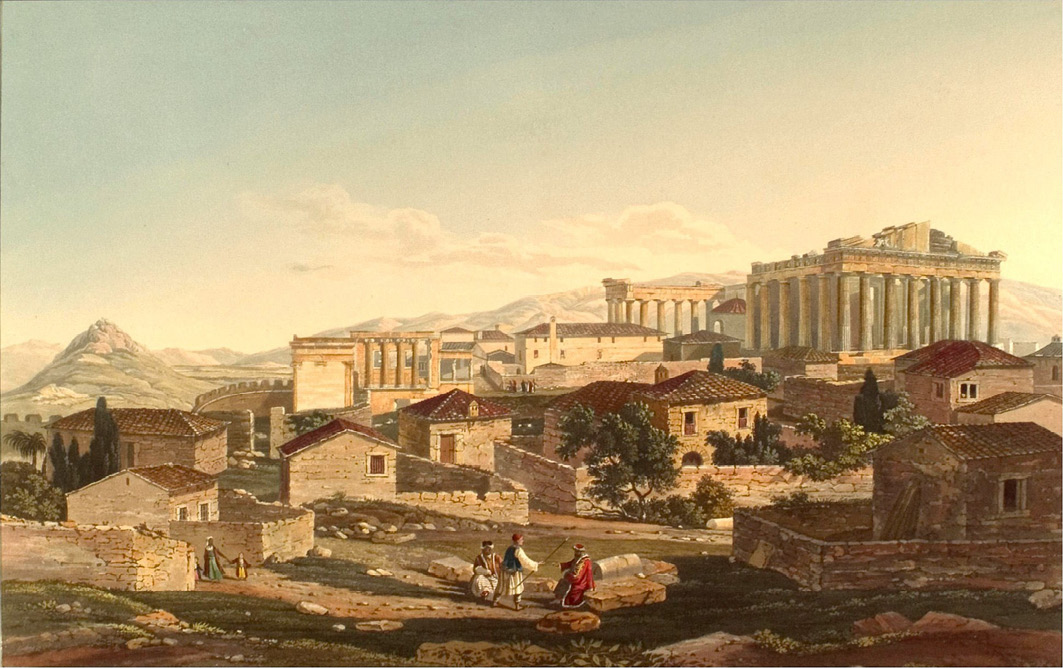
Figure 2.8. ‘The West Front of the Parthenon and the Erechtheion’. Coloured aquatint from a drawing by Edward Dodwell. Wikimedia Commons, public domain, https://commons.wikimedia.org/wiki/File:The_west_front_of_the_Parthenon_and_the_Erechtheion,_from_the_Propylaea_-_Dodwell_Edward_-_1819.jpg
Another view, made before Elgin’s removals that began in 1801 is reproduced as Figure 2.9.
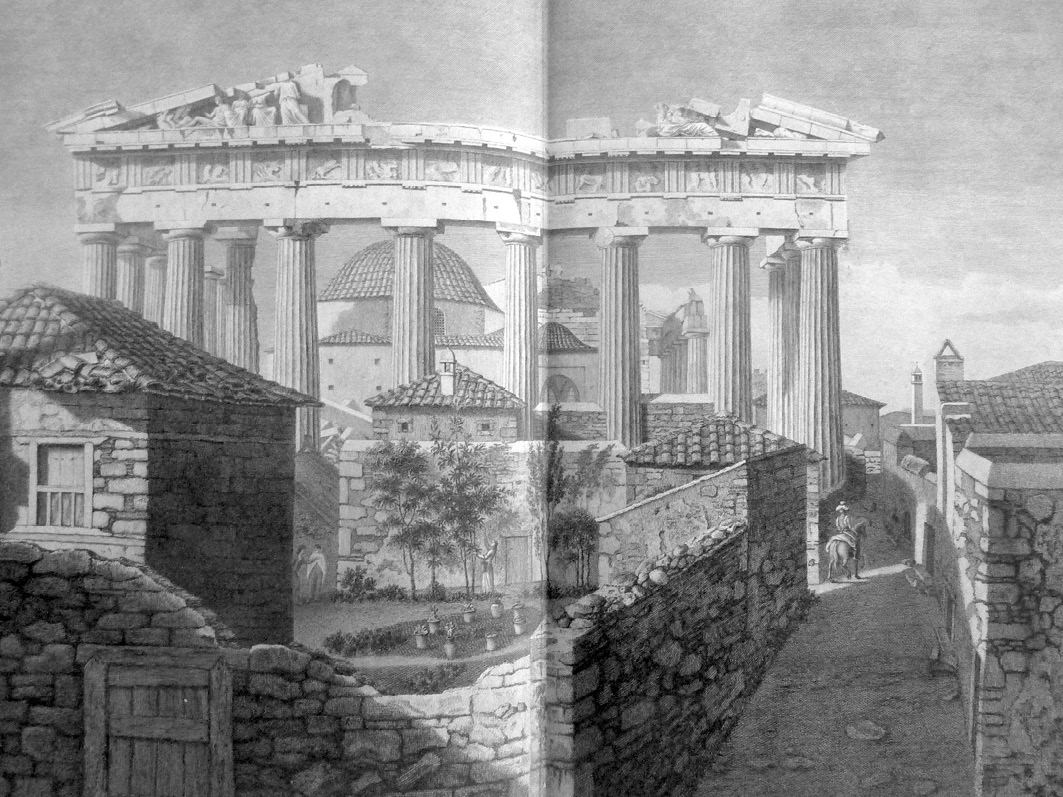
Figure 2.9. ‘View of the Eastern Portico of the Temple of Minerva, at Athens, called the Parthenon’. Copper engraving.45
The chimney-like structures to be seen on top of some of the houses, a common feature across the Middle East, were designed to catch any breezes, draw the air down, and to help to cool the interiors.
Figure 2.10 shows another view of the town on the Acropolis, taken in 1765 that gives a reasonably realistic view of the east end of the Parthenon before the removals by the agents of Lord Elgin. According to Sir Richard Worsley, who published the engraving in his book, when he visited in 1785, ‘no further dilapidations had taken place.’46 From this picture it emerges that at the east end of the summit, the furthest from the entrance gate, were some substantial buildings that, from their design, predated the Ottoman takeover in the fifteenth century, including what are probably stables.47 There were however more houses than were needed by the garrison, some of whose members lived in the lower town when not on duty, and many houses on the Acropolis were untenanted.48
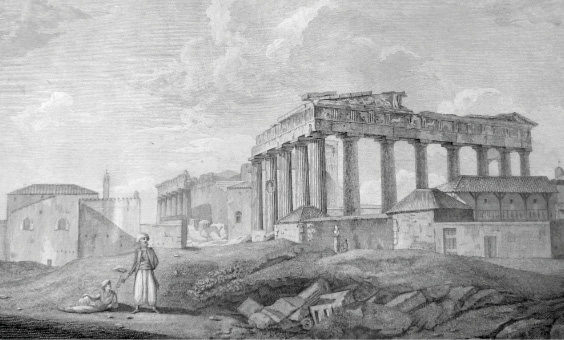
Figure 2.10. ‘View of the Parthenon, shewing the situation of the sculptures of the metopes and the frieze’. Copper engraving.49
In 1825 or 1826, when Athens and the Acropolis were under the control of the Greek insurgents, and an attack by the Ottoman army was expected, the local commander, Yannis Gouras, commissioned an experienced French officer to prepare a military map of Athens that is also helpful in understanding what happened in Athens and its monuments during the Revolutionary War. A copy is reproduced as Figure 2.11.
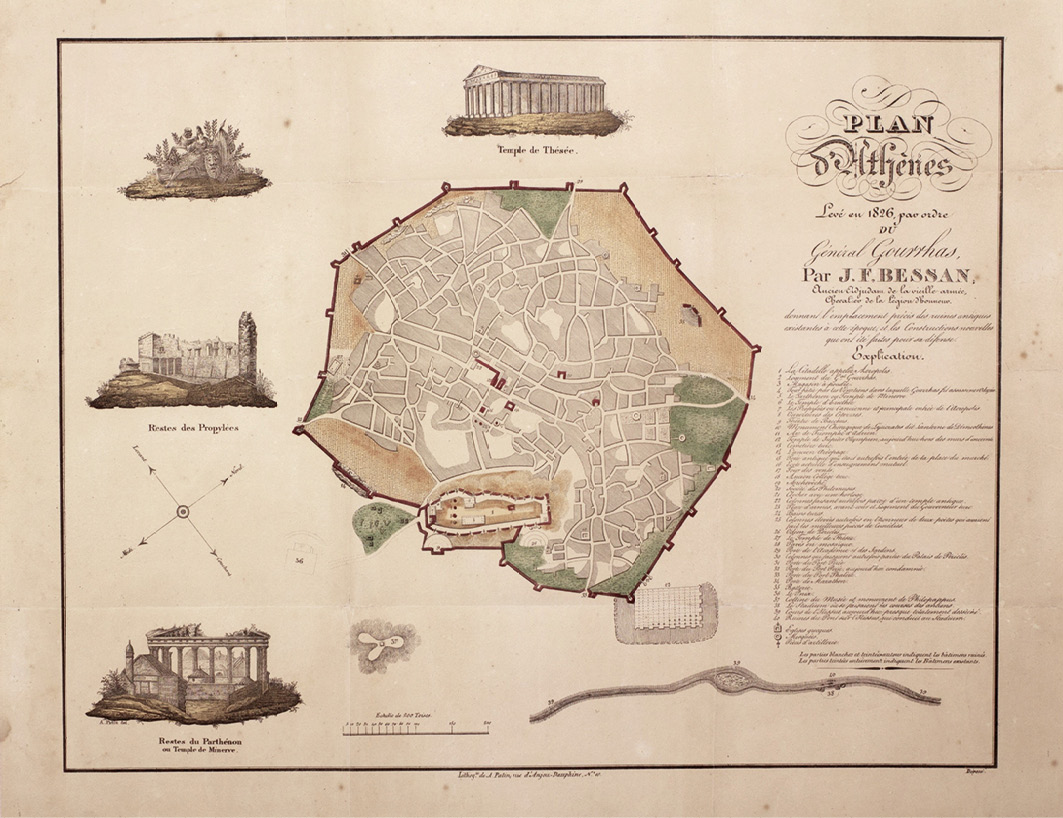
Figure 2.11. ‘Plan d’Athènes levé en 1826 par ordre du général Gourrhas. Par J.F. Bessan … donnant l’emplacement précis des ruines antiques existantes à cette époque et les constructions nouvelles qui ont été faites pour sa défense’. Lithograph, hand-tinted at the time it was made.50
A detail showing the Acropolis is at Figure 2.12.
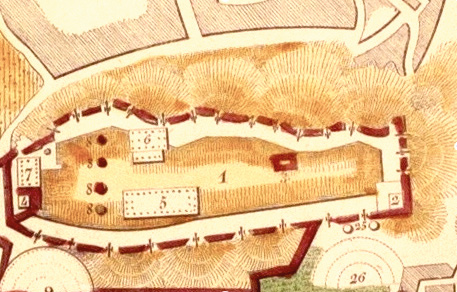
Figure 2.12. Detail from Bessan’s map (Figure 2.11 above), showing the Acropolis.
From the numerous accounts by eyewitnesses, we can say with confidence that much of the detail is not accurate. Anyone with military knowledge understood that in any siege it was vital to ensure that the gunpowder magazines were protected from hot shot aimed at igniting them. The Propylaia had been badly damaged in 1640 in time of peace when the gunpowder stored in the building was ignited apparently accidentally by lightning.51 The Parthenon, which had previously been structurally complete since ancient times, had been reduced to a ruin in 1687 when a mortar bomb fired by a besieging force penetrated the roof, set off an explosion, killed many people, and caused a fire that the besieged army, with little water, had no means of extinguishing. When the invading western army of General Morosini heard that the Parthenon was being used to store explosives, it had needed only ‘a small number of shots’ to hit the Parthenon with a mortar.52
With two ancient buildings destroyed by gunpowder explosions, the third and last, the Erechtheion, had been adapted into a gunpowder magazine by the Ottoman forces at some time before the Revolution. Since the whole Acropolis was within range of artillery shelling from the hills that lay just outside the town wall, and the Ottoman army, famed for its modern artillery, was able to send shots into defended structures, it was vital to protect the magazine.53 The careful precautions against the risk of the gunpowder being set alight by accident or by bombardment, that involved enclosing a chamber in the Erechtheion with marble blocks, so that it offered only one small entrance, and how the magazine was further protected by a brick vault of uncertain age within, were described by the British architect Joseph Woods in a letter written during his visit in 1818.54 The gunpowder magazine was still in use when Edward Blaquiere visited the Acropolis on 24 July 1824, with the Greek Revolutionaries who were then in possession, having not yet found a safer place.55 There is a report that the magazine was moved, although where it was located during the months of bombardment of 1826/27 is not known.56
The map also shows many more cannon mounted on the battlements than were ever deployed there during the Revolution.57 The water cisterns on the summit, that Yannis Gouras had had cleaned and filled in the years between 1822 and 1826, are marked as larger and more numerous than they were, and the map gives no indication of the more important water cisterns on the slopes within the Serpenji that were also brought back into use at that time. The location of the commandant’s house on the Acropolis, that Gouras took over from the Ottoman disdar, in modern terms the command-and-control centre, appears also to have been misplaced.58
The map, therefore, cannot be trusted. It is as if it were intended to mislead both friends and the enemies about the military strength of the Acropolis. Whatever its exact status and intended viewerships, with its picturesque vignettes of the ruins of Athens, mostly copied from eighteenth century engravings, the map is, if not a ruse de guerre, certainly a document of persuasion, aimed both at local participants in the war and at philhellenic viewers in France and elsewhere who supplied armaments, money, and military expertise.
Unusually, however, we also now have a map prepared by the Ottoman authorities during the Greek Revolution.59 The main inscription reads: “This is a Map of the Castle of Athens including the city and the protective wall, conquered with the help of Almighty God”. This is followed by the date 11 Zilkade 1242 Hegira year, corresponding in the western European calendar to 6 June 1827, the date on which the Acropolis was surrendered to Reschid’s forces. There is however also another date, the Ottoman equivalent of 13 October 1826, that implies that the map was prepared earlier, during the period when the Acropolis was in the hands of the Greek Revolutionaries. What relationship the Ottoman map bears to that prepared by Bessan is not yet certain.60 It too appears to show more cisterns and mounted artillery than was ever there. But by contrast it shows no interest at all in the ancient monuments. On the eve of the Greek Revolution, to the western visitors, and increasingly to the leaders of local Orthodox population, the Parthenon was a ruin inside which the Muslims had built a mosque. To the Ottomans it was a mosque surrounded by the ruins of a building constructed long ago by an idolatrous people whose civilization the Christians had superseded.
Places of Worship and Greek Cultural Heritage
In 1809, thirteen years before the outbreak of the Revolution, Athens was said to contain one Greek Orthodox cathedral (the ‘little metropolitan’), plus thirty-nine churches and over eighty Christian chapels, including several in the caves on the Acropolis slopes, that were only occasionally in use.61 According to an English churchman who made inquiries on the spot in 1818, there were thirty churches with their own priest, and around three hundred chapels and shrines.62 There were eleven mosques including some with minarets, a small mosque that had been built in the early eighteenth century inside the recently ruined Parthenon, and numerous Muslim shrines. In 1678, Evliya had counted four ‘Friday mosques’, that is, mosques in regular use for weekly services, including the small one built inside the ruined Parthenon, seven neighbourhood mosques, one religious school, three primary schools, three dervish convents, and three Turkish baths.63 The tallest working building in Athens, which dominated the skyline of the lower town, was the mosque known as Fethiye, that had been adapted from a Christian basilica at the time when Sultan Mehmet the Second came to Athens in 1456, after his armies had taken Constantinople in 1458 and who had guaranteed the position of the Orthodox Church. It survives today, although desacralized and without its minaret. A new mosque was built in central Athens in 1759.64 From viewing stations inland, many of the dozen or so monuments surviving from antiquity were visible among the domes of the churches and the minarets of the mosques.65
The visual influence of places of worship extended beyond the buildings themselves. An industry producing visual images for display in Orthodox Christian churches and in private homes had existed in and around Athens for centuries before the Revolution, part of a network of picture-makers that served Orthodox communities in the eastern Mediterranean region.66 With few exceptions, the only forms of image that the Orthodox ecclesiastical authorities permitted were in two dimensions and the only allowable content were stories of the early history of the religion and of its saints, martyrs, and heroes, which their viewers easily recognized by standard markers whose conventions, learned as part of childhood education, were shared by consumers and producers.
Within some churches, or in the entrance chambers, it also became a custom to display images of sinners suffering in hell alongside the anti-heroes of the religion, such as Judas Iscariot who had betrayed Jesus, and the Byzantine Emperor Julian who had tried to reverse the policy of Christianization of the Emperor Constantine, who had led a successful rebellion by marching an army into Rome and defeating the sitting emperor at the battle of the Milvian bridge in 312 CE.67 Some entrance chambers pictured persons whom they regarded as contemporary adversaries of their community such as the ‘schismatic’ Roman Catholics who had broken away from the Orthodox church, and occasionally Muslims.68 On the Princes Islands in the sea of Marmara, within sight of the minarets of Constantinople, the French countess Isabelle de Ferté-Meun, who wrote a book about her life there in 1816 and 1817 during which, as the wife of an affluent Frank, with diplomatic privileges, she explored the churches and former churches, reported seeing dragomans in the picture of hell.69
During the long eighteenth century, the painters of Athens appear to have been organized, as elsewhere, into guilds that regulated entry to the industry, supervised the training, settled internal disputes, and generally managed standards, prices, and production. As is a feature of guilds, perhaps the commonest form of industrial organization in most societies before modern times, the membership appears to have included a large hereditary element as boys learned their trade from assisting their fathers and uncles in their workshops, while those who showed unusual promise were apprenticed to experienced masters beyond the family. The guilds maintained the prototypes or patterns (‘anthibola’), a system of pictorial control inherited from the time of the Byzantine Empire, explicitly recorded as early as 1436 in one of the few non-ecclesiastical primary contemporary texts surviving from that time, the will of the painter Angelo Acontato.70 Since the painters were exclusively drawn from the Orthodox community, and their main customers were those who had responsibility for church buildings, they were, in practice, forbidden to produce non-religious images except in territories outside the Ottoman millet system—a system in which the Muslim, Orthodox, Armenian, Coptic, Maronite, Jewish, and other religious communities were accorded a large degree of autonomy under the supervision of their religious leaders.71 The guilds can thus be regarded as a branch of the Orthodox jurisdiction in pre-Revolutionary Ottoman Greece. El Greco, for example, often regarded as a painter in the western sense of the Spanish school, produced images in both traditions.72
Many of the pictures to be seen in Athens before the Revolution were produced in workshops on church-owned premises, such as monasteries in the hills or in small offshore islands, where valuable materials, such as gold leaf, could be kept secure from theft by outsiders, and to a lesser extent, embezzlement by insiders. The industry, whose customers were also its regulators, enjoyed a monopoly guaranteed by the Ottoman state and controlled both the stock of fixed capital and the human resources employed, so enabling the authorities of the guild to regulate the output, the pricing, and the visual content. For many centuries before the Greek Revolution, the only non-ecclesiastical visual images that the local Orthodox population encountered were those made by foreigners. In a few locations, notably Athens, foreign artists were frequently to be seen making the sketches that, when worked up in studios and workshops abroad, would become paintings and engravings.73
The changing religions of the city’s population were also reflected in the use, reuse and disuse of some of its buildings. Figure 2.6 shows how the alterations made to Hadrian’s Gate and the nearby section of the town wall had included blocks of finely cut marble. They had been recycled from the small classical-era building now known as the ‘Ionic temple on the Ilissus’, that had been situated in what was then open country nearby, close to the river of that name. That temple had been converted into a church in the early Christian centuries, but had fallen into disuse as the population of Athens had shrunk. It can be seen in the picture shown as Figure 2.13.
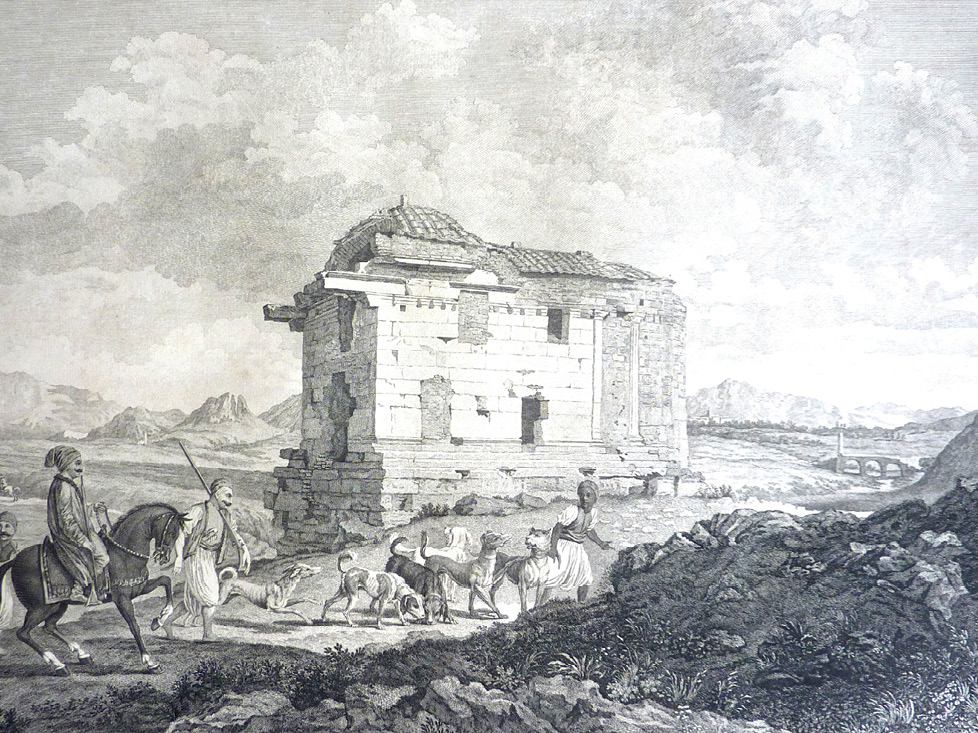
Figure 2.13. ‘The Ionic Temple on the Ilisus’. Copper engraving.74
The men pictured are the voivode and his party on a hunting trip, an event that might have happened in ancient times, an example of a long continuity that convinced eighteenth-century visitors to Athens that the ‘Nature’ they found in Greece was largely unchanged since antiquity. Although the strangely shaped building had long ago been identified by western visitors as among those described by the ancient author Pausanias in the second century CE as a fine classical-era building that had been in active use for over two thousand years, the engraving is the only picture ever made.75
Figure 2.13 also brings out how, at some time after the end of antiquity, more than a thousand years earlier, the Orthodox Christians who had been accorded a formal monopoly over religious practices in the Byzantine Empire visually asserted the drastic change from ancient Hellenic practice. By adapting the architectural design from walls, columns, and lintels made of marble, to the shape of a domed basilica made in part from bricks and tiles, they had transformed a sacred building in whose vicinity in ancient times ceremonies involving the killing, roasting, and eating of animals were performed by participants in the open air, into an indoor darkened space within whose walls Christian rites were performed by professional priests in the presence of a congregation of the local community. As with the Parthenon on the Acropolis, so with the Theseion in the town, and other ancient temples turned into churches elsewhere, the leaderships of the Christian theocracy had brought religion indoors.76
With the slow decline in the population of Athens, the church of ‘St Mary on the Rock’, as the adapted Ionic temple was called, had ceased to be in regular use by June 1669.77 It was dismantled in the late 1760s by order of the Archbishop and Orthodox authorities of Athens, the money raised from the sale of the building materials being used to finance the construction of churches within the town.78 Richard Chandler, whose main purpose in visiting Greece was to report on how far any monuments from antiquity still survived, predicted in 1765 that it would soon be gone altogether as ‘the materials will be removed, as wanted.’79 When Baron Riedesel visited Athens in 1768, all that remained was a single column with its Ionic capital.80 What little then remained was demolished by Haseki to provide materials for the town wall.81 The church was replaced by a small chapel where, on the saint’s day, a detachable icon was set up and removed after the ceremonies were over.82
At the time of the abandonment and demolition of the Ionic temple, there was evidently little sense among the Greek Orthodox population of Athens that the ancient building had any claim to be preserved, let alone that their contemporary identity was related to the ruins of ancient Hellas.83 Scattered evidence has been found of a memory of the pre-Christian past persisting among the country people who had little contact with the foreign visitors and whose opinions may therefore have claims to have been indigenous in the sense of being uninfluenced by intellectual developments in western Europe, and may possibly be indications of continuity. The tombs disturbed by the ploughs of the country people were said to be those of legendary, semi-supernatural giants, as tall as poplar trees, of ‘Hellenes’ who could leap across rivers in one stride, and pick up marble blocks with one hand and throw them from island to island. The epic poem Erotokritos, written in the early seventeenth century and evidently reflecting the official ecclesiastical teaching and implicit censorship of that time, noted that the ‘Hellenes’ had not been Christians, and their religion had neither roots nor foundations.84 In 1809, John Galt, who drew his information from Padre Paolo, the superintendent of the building belonging to the Roman Catholic Capuchins, who had lived in Athens for decades, recorded that the Albanians who did most of the agricultural work frequently came across pieces of sculpture that, in accordance with their religion, they always destroyed, ‘believing them to be works of the devil, framed in order to tempt mankind to return again to idolatry’. Galt, as a member of the Scottish Presbyterian Church whose members had destroyed many images at the time of the Protestant Reformation, fully approved.85
The loss of the Ionic temple was referred to by Lord Elgin as evidence of the alleged indifference of the people of Athens to the ancient monuments at the time his agents were active, and as an assessment of local Orthodox attitudes in the middle of the eighteenth century, it may have been fair.86 Nor is there any reason to doubt Elgin’s claim that the Archbishop of Athens cooperated in allowing Elgin’s agents to search church properties for ancient sculptures and inscriptions built into the walls (‘spolia’), and that he had had the Archbishop’s authority to remove them.87 Many others were allowed to take away antiquities, statues, inscriptions, painted pottery, coins, and other antiquities, including jewellery and other grave goods without restriction, although gifts were normally given as part of the transactions.
A Changing View of the Classical Past
The first mention of the ancient monuments being invoked as symbols of a newly emerging nationalism that I have found in my research is in a petition made to the Russian Empress Catherine by a number of overseas Greeks in April 1790 asking for Russian help in throwing off Muslim rule: ‘our superb ruins speak to our eyes and tell us of our ancient grandeur.’88 However, a few decades would pass before these views took root, as both the Orthodox Church and the Ottoman rulers held very different views of the Classical past.
From its earliest stirrings, Enlightenment-inspired talk of ‘liberty’ arriving in Ottoman territories from the time of the French Revolution had been condemned by the Orthodox patriarchs as ‘an ambush of the Devil’ designed to lead the people to destruction by enticing them from their lawful, that is, their Ottoman, rulers.89 The Ottoman Empire, Patriarch Anthimos declared, had been created by the Christian god to protect the true, that is, the Orthodox, Christians from the schismatic Roman Catholics who had broken away from the Church in 1054 CE.90 In 1793 and again in 1798, the Patriarchate of Constantinople condemned the importation of western Enlightenment ideas and the printed books that carried them. In deciding to take up arms, the insurgents of 1821 were therefore in revolt not only against the Ottoman Empire, but they were defying the leadership of the institution on which their identity had been re-founded and preserved for around fifteen hundred years. Even in 1828, when Greek national independence had been secured in all but name, the Patriarchate of Constantinople was demanding that the Orthodox return to their allegiance.91
As for the Ottoman attitudes to the ancient ruins, the official Muslim discourse was that all representational images were forbidden and ‘idolatrous.’ In this regard the Muslims followed the texts of the ancient Jewish and Judaeo-Christian bibles, among the most influential of which were the reported opinions of Paul of Tarsus, whose speech in Athens was repeated and built on by many early Christian writers.92 In the Koran (‘Qur’an’), the Prophet drives out the idolaters from Mecca and destroys their idols, just as in early Christian writings Paul and Philip are said to have destroyed the idols of Athens, and other saints, notably James, are said to have done the same in other Hellenic cities such as Ephesus. In the Koran there are other similarities with the early Christian discourses, including the association of statues with ‘demons’ and the ‘filth’ that refers to the ritual slaughter of animals and the spreading of the blood and some of the inedible parts for the gods.93
It was possible, perhaps even common for Muslims, to claim to admire the works of some of the ancient Hellenic writers, notably Plato, while simultaneously condemning Hellenic visual images. So the firman94 arranged by Elgin in 1801, a formal document that we can take as an example of official Ottoman and Muslim mainstream discourse at that time, of which I offer a new transcription and translation in Appendix A, refers to the Parthenon both as a place of the ‘philosophers’ [good] and as a temple of ‘idols’ [bad]. Evliya, in telling a story of how the Ottoman naval port of Negropont (Chalcis or Egriboz) was founded in the fifteenth century, describes the naval commander as acting ‘with the genius of Aristotle’, in cutting a way through the strait, capturing ten Venetian ships, and returning to Constantinople,’ having overturned the idols of the infidels, with their crosses.’95 In these respects formal Islamic discourses had much in common with Christian discourses at the time of the Revolution. In practice, however, since many ancient buildings had been transformed into churches or mosques, as was the case with the Parthenon, they were religious buildings under Ottoman state protection as part of the millet settlement.
The Philhellenes and Their Influence
Philhellenism, the nexus of ideas that asserted the identity of the present day with the ancient Greeks, had made much progress, both in western European countries and among the Greek diaspora, during the eighteenth century. By 1763, perhaps as part of the modern European Enlightenment, we hear the beginnings of a local discourse of ‘our ancestors’, although at that time neo-Hellenism was still more of a literary movement led by foreigners and by westernised Orthodox Greeks living outside the Ottoman territories, mainly in Paris, Vienna, and Venice, than a local political or revolutionary project.96
There are occasional indications of changes of attitude on the way. We hear, for example, of a deputy Pasha of the Morea who in 1809 ordered that a translation of the ancient Greek travel writer Pausanias into Romaic (modern Greek) should be made and who personally visited Athens, ‘in order to see, as he declared, himself, those remains and monuments which attracted so many Europeans so far from home.’97
In 1813, however, as an example of the rapid progress of the idea, a number of prominent Athenians established the Philomuse Society that aimed to improve local education in the ancient Greek classics and to study and preserve antiquities.98 It quickly established a library of about forty volumes, mostly about Greece, that visitors could use by paying a subscription. Four years earlier John Galt, who had brought no books with him, had lamented that he had had to rely on his memory, for ‘books are not to be purchased here.’99
After the successful effort made in the century after independence to make the Athenian Acropolis the symbol of the new nation of Greece, and the constructing of a national history that used the ancient monuments as a heritage that connected the modern with the ancient Hellenes, it still comes as a surprise to discover how recent the change in attitudes to the monuments had been.100 Immediately after the end of the Revolutionary War, for example, Ioannes Makriyannis, one of the most famous of its heroes, in memoirs begun in 1829 but not printed till 1907, is said to have told some soldiers who were about to sell ancient statues to Europeans: ‘You should not let these leave our country […] For it is for these we fought.’101 The Greek soldier, Peter Mengous, who took part in many campaigns, and whose autobiography is less influenced by hindsight than the oral histories written down by famous commanders, records his searching for antiquities to sell to foreigners, including a marble bust of Socrates and a marble relief of three female figures. He writes of his business in matter-of-fact terms without any suggestion that he was caught in a dilemma, let alone that he was being disloyal to the aims of the Revolution.102
One sign that Greek perceptions of identity before and during the Revolution were shifting was the growing practice of naming children after the famous men and women of ancient Athens rather than the traditional Orthodox Christian saints, a trend the Church authorities tried to halt. In 1818, for example, Demetrios Zographos, who gave lodgings to visitors from the West, had named his sons Miltiades, Themistocles, Alcibiades, and Pericles, and his daughter Aspasia.103 Koraes himself, however, one of the intellectual fathers of neo-Hellenism, never called himself a Hellene, nor did he use ‘Hellenes’ except when referring to the ancients.104 In the Revolution many insurgents called themselves ‘Hellenes’ from the start, so distinguishing themselves from their Orthodox co-religionists, using language to splinter off a component of the previous identity.105
The Acropolis as a Symbol of a New Greek Identity
Before the Revolution the Acropolis, as an imperial military fortress, was administered direct from the court in Constantinople, formally the sultan himself through firmans sent by the grand vizier, the highest official of the Empire. The commander of the Acropolis, the disdar, a low-ranking officer of much the same military status as a sergeant in a western army, was not answerable to the local governors of the towns and provinces, the voivodes and pashas, but only to the military authorities. As part of his responsibilities, he ensured that nothing could be removed from the Acropolis or altered without specific authority from Constantinople. And if the fortress were attacked or besieged, without specific permission, it was not open to local commanders to make terms of surrender.106 Apart from a few months in 1688/89, when the Acropolis had been occupied and then abandoned by a western army under the command of the Venetian general Morosini, its international legal status had not changed since it had been surrendered by the ruling Italian ducal family to the forces of Sultan Mehmet the Second in 1458, shortly after his army had taken Constantinople in 1453.107 Already by the early modern period, with the arrival of gunpowder, firearms, and artillery in the form of cannon and later of mortars and howitzers, its military limitations had been exposed. But, while what is now called its ‘hard power’ had steadily declined, in the eyes of the arriving westerners its symbolic and cultural ‘soft power’ was on the rise.
From the reports of travellers we can detect a shift from maintaining the Acropolis as a fortress from which foreigners were excluded to exploiting it as an income-generating tourist attraction. Removals of antiquities, however, continued to be forbidden. In 1786, for example, Lady Craven, seeing the many fragments of sculpture from the Parthenon lying on the summit, was refused permission to take ‘even a finger or a toe.’ The disdar, even after a long negotiation, said that if he agreed he would have his head struck off.108
The Ottoman documents that are now available relating to the firman that allowed a large part of Elgin’s collection to be exported from Ottoman jurisdiction in 1809 make no reference to the fact that the terms of the firman of 1801 were exceeded. Nor do they reveal any concern about the nature of the contents of the collection as pieces taken from ancient buildings. They treated the matter not as one of idolatry or incipient local nationalism, let alone as national heritage, but as foreign properties sequestrated during the recent war now being returned to owners as part of the peace settlement.109
What is striking, at first sight, is to find in an intercepted letter to the sultan from Reschid Pasha, the Ottoman commander who besieged the Acropolis in 1826/7, that it was western philhellenes who had come to Greece to fight who are castigated as idolatrous, and the monuments of Athens the object of their idolatry. It was the Acropolis that brought them: ‘to fight with their Greek co-religionists and offer their impure blood in sacrifice to vile and dumb idols that they appreciate and worship in their deplorable ignorance.’110 Reschid writes like Paul of Tarsus, Augustine of Hippo, Tertullian, and the image-haters of the western European churches who had split from the Roman Catholics as part of the European Protestant Reformation who drew their ideas from the early Christian writings and re-performed them both in their words and in their deeds.111 Reschid was, however, picking up on a more general point: the Muslims had their mosques, the Orthodox had their churches, and the Jews their synagogues. To the Franks from Europe, the Parthenon and other ancient buildings were being increasingly perceived and presented not quite as modern temples to modern gods but as ‘works of art’ to be ‘rapturously’ admired and adored in much the same language.112
The extent to which the Greek Orthodox population visited the Acropolis, except occasionally as workmen or as guides or servants of visitors, is hard to judge, but they had little reason to go there even if regular access had been permitted, as seems unlikely.113 Although all the inhabitants of Athens knew the ancient monuments of the town among which they lived, few would have regularly seen those inside the Acropolis. And it was only from outside the town wall that they saw the Parthenon, the distant and middle-distance view having apparently been those to which the ancient designers had given the highest priority. From the lands to the west, then mainly used for grazing, the west pediment was visible, as shown in Figure 2.13. However, it would have been difficult to make out much of the pedimental sculpture, from which the paint had long gone, even before it was damaged in the siege of 1687 and after almost all the remaining pieces were removed by Elgin’s agents after 1801. Although evidence is scanty, it seems likely too that, until the generation immediately before the Revolution, the ancient monuments were regarded by the Orthodox leaderships as of more importance to the Franks than to themselves. In, for example, the chronicle of the history of Athens until 1800 that was composed by the scholar Ioannes Benizelos at some time before 1821, he notes that the magnificent sculptures of the Parthenon ‘caused astonishment and admiration among all visitors’ without saying that he or other local people shared these feelings.114 And that appears to have also been the view of the Ottoman leaderships.
Elgin’s removals of pieces of the Parthenon and the other buildings on the Acropolis, made with the help of a team of about twenty locally recruited workmen, seem to have accelerated the change in local attitudes. According to Edward Dodwell, who had been present and who was generally well informed: ‘The Constantinopolitan patriarch has been induced by the Greeks, who are fondly anticipating the regeneration of their country, to issue circular orders to all the Greeks not to disturb any ancient remains; and neither to assist nor connive at their destruction nor removal, under pain of excommunication. The plunder of the Athenian temples was the cause of this necessary measure.’115 Since no text has been found and we only have a range for the date, we can only guess at the explanation that the Patriarch offered his subordinates, but we can be confident that he would not have publicly associated himself with talk of revolution.
The Ecosystem of the Acropolis Before the Revolution
Each year the hill of the Acropolis performed the regular cycle of the seasons. In the spring, its slopes blazed with wild violets, crocuses, and anemones, as it had done in ancient times.116 During the hot summer months, it appeared as a grey rock standing in a brown, treeless, dusty, landscape. This was still the same Athens, as the occasional tempests seemed to confirm, as had suffered a catastrophic flood in mythic times, one of the reasons why, as was reported by ancient authors, the first inhabitants had taken refuge in the caves of the Acropolis slopes.117
Athena’s owls, the main symbol on the coinage of the ancient city, still fluttered round the Acropolis.118 Snakes, another common symbol of ancient Athens, still lurked in the caves and crevices of the slopes, and the frogs still croaked ‘brek ek, co-ax, co-ax, co-ax’ as they had done in 405 BCE when Aristophanes had won first prize for his comedy, The Frogs. Thanks to the blog of Diana Gilliland Wright, you can now hear them too.119 During the summer months, Athens teemed with storks another continuity from ancient times. Their strange clicking noise, that you can also now hear, made a counterpoint to the Muslim calls to prayer from the minarets.120
Before the Revolution, many families of storks arrived every year near the end of March.121 The domes of the mosques of Athens, crowned by the nests of the storks, were noticed by Chateaubriand when he caught his first distant sight of Athens in 1806. Having seen storks in his travels in Canada, they were, he concluded, a species, like the human, that was equally at home in all the continents and climates of the world.122 As he wrote: ‘In meeting with them again in another species of desert, on the ruins of the Parthenon, I could not forbear devoting a few words to my old friends.’123 Chateaubriand’s mention of storks on the Parthenon makes him the only author since ancient times explicitly to notice them there, an example of the selecting eye eliding what the brain interprets as a an irrelevant or unwelcome intrusion. The storks of the Acropolis were, however, shown as incidental features in three engravings from sketches made on the spot by the young architect Charles Robert Cockerell in 1810. Two are reproduced, as they appeared in the book, slightly tinted, in Figures 2.14 and 2.15.
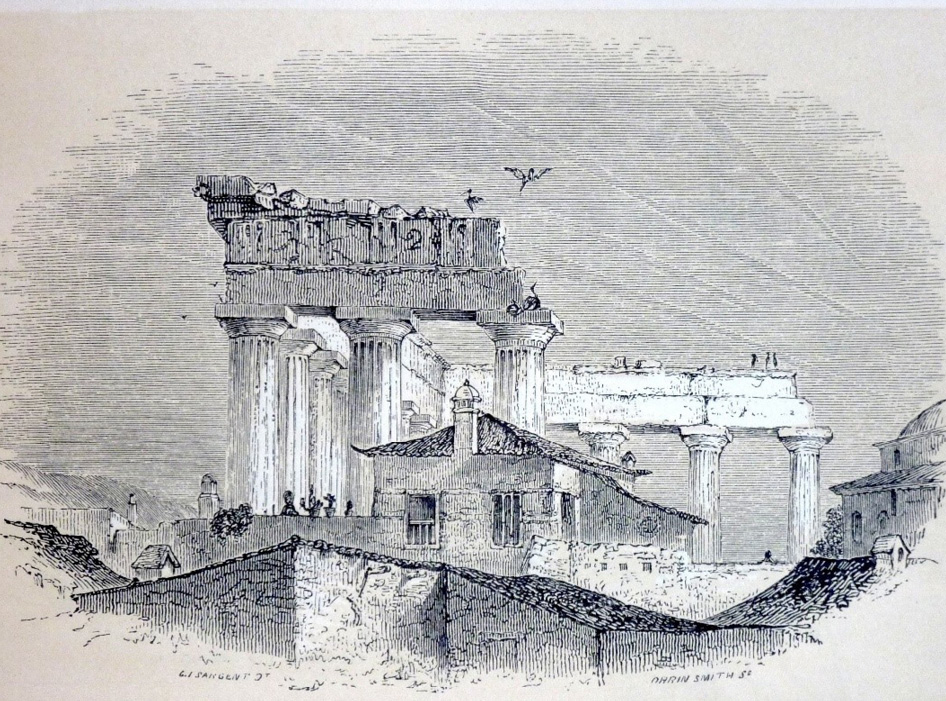
Figure 2.14. ‘North East Corner of the Parthenon’. Woodcut c.1831, Sargent del. Darin Smith sc. From a sketch by Cockerell, 1810.124
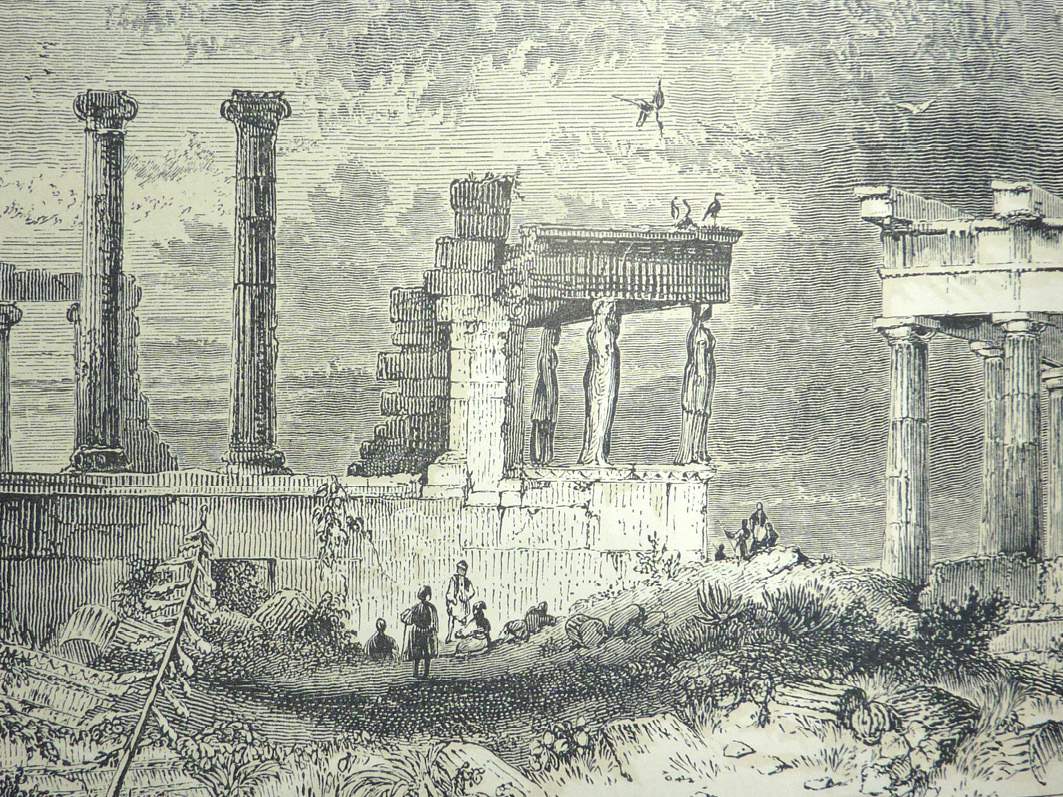
Figure 2.15. ‘The Parthenon and Erectheum’. Woodcut c.1831 by J. Whimper, from a sketch by Cockerell, 1810.125
The naturalist Sibthorp noted: ‘The domestic stork, a privileged bird, arrives regularly at Athens, sometimes in the month of March; and leaves it when the young are able to support the fatigues of a long flight, about the middle of August.’126 According to the naturalist Frédéric Hasselquist, writing more than seventy years before, it was a capital offence for a Christian to kill a stork.127 The storks of Athens, that were to be among the casualties of the Greek Revolution that was intended to restore the built heritage of classical Athens, had incidentally destroyed one of the features that some of the most highly regarded writers of that age, including Plato and Aristotle, had included in their world view and their understanding of the place of humans in that world.128
Besides including the storks that other artists omitted, Cockerell gives us in Figure 2.16 a glimpse of how the little owls, that were even more central to the self-fashioning of classical Athens, were encountered as darting flashing pairs of eyes.129
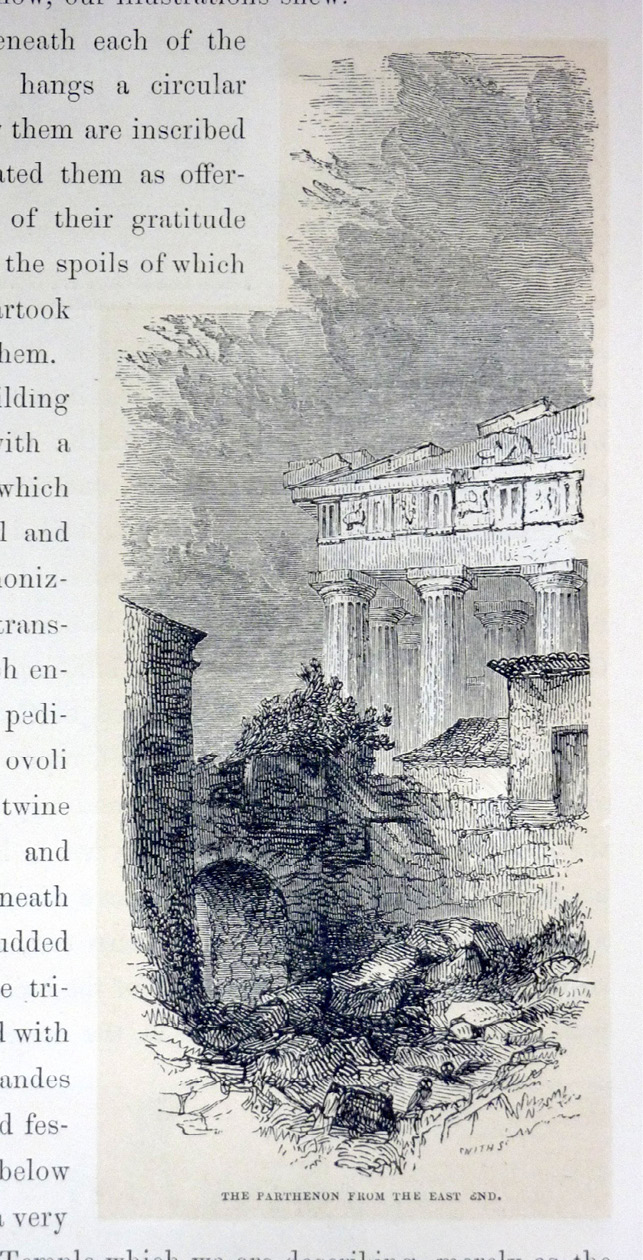
Figure 2.16. ‘The Parthenon from the East End’. Woodcut.130
During the recent centuries for which we have records, domestic animals, including dogs, goats, donkeys, mules, and horses were kept on the summit, as were domestic fowls, as well as human activities including burials, all of which helped to fertilize and deepen the soil and to encourage the insects on which wild birds fed.131 During the nineteenth century, as was estimated at the time, 120,000 cubic metres of earth was removed from the summit and dispersed, as the site was excavated down to the bedrock.132 How much of that earth had remained from what was there before the summit was first settled in Neolithic times and how much was later accumulations, cannot now be determined. In ancient times too, however, the Acropolis summit was evidently a green space, almost a garden town, where wild birds shared the natural environment for their food and the human built environment for their nesting sites, a fact that deserves to be included in any attempt to recover ancient ways of seeing.133 The ecological destruction of the Acropolis is discussed more fully in Chapter 21. It could not have been foreseen by the inhabitants of Athens on the eve of the Revolution whose lives we discuss in the following chapter.
1 From Hobhouse, J.C., A Journey through Albania and other Provinces of Turkey in Europe and Asia to Constantinople (London: Cawthorn, second edition, 1813), folded and tipped in after ii, 292. Composed by the soon-to-be-famous British architect in the neo-Hellenic style Charles Robert Cockerell. That Hobhouse sought a favour from Cockerell emerges from his letter in Byron’s Bulldog: The Letters of John Cam Hobhouse edited by Peter W. Graham (Columbus, Ohio: Ohio State UP, 1984), 47. A similar picturesque view, ‘Athens from the foot of Mount Anchesmos,’ made c.1805, is in Dodwell, Edward, Views in Greece from Drawings by Edward Dodwell (London: Rodwell and Martin, 1821), unnumbered.
2 Memoirs of the Life and Gospel Labours of Stephen Grellet, edited by Benjamin Seebohm, volume 2 (London: Bennett, 1861), 19.
3 For example: ‘Overthrowne and vtterly destroyed by the Turks.’ Itinerarium Totius Sacrae Scripturae, or, The Trauels of the holy Patriarchs … with a Description of the Townes and Places to which they travelled, and how many English miles they stood from Ierusalem (London: Adam Islip, 1638), 543. That book had first been published in Latin by Heinrich Bünting in 1581 when opportunities to check such statements on the ground were few. Lithgow’s book was reprinted for many decades after the time of his visit, entrenching other errors.
4 Lithgow, William, The Totall Discourse of the Rare Adventures & Painful Peregrinations of long Nineteene Yeares Travayles, from Scotland to the most famous Kingdomes in Europe, Asia and Africa (Glasgow: Maclehose reprint, 1906), 66. In 1624 Lewis Roberts also felt obliged to contradict the story that Athens no longer existed, although he only saw the Acropolis from the sea, and was evidently reporting what he had read or been told. Roberts, unpublished manuscript journal noted in the Bibliography.
5 Burnouf, Émile, La Ville et l’Acropole d’Athènes aux diverses époques (Paris: Maisonneuve, 1877), 18. The clearances are discussed in Chapter 22.
6 Undated and signed only with the name of the engraver ‘J. B. Peterson sculp.’ A copy in Bonn says Hübsch del.1819/ Schilbach sc. 1823. The artist is known to have visited Athens and his composition appears to be independent of the more familiar one, made earlier by Stuart and Revett for The Antiquities of Athens.
7 As noted explicitly by, for example, Giffard, Edward, A Short Visit to the Ionian Islands, Athens, and the Morea (London: Murray, 1837), 138.
8 Summarized from the plentiful documentary record by Sicilianos, Demetrios, Old and New Athens (London: Putnam, 1960), 28–94.
9 They can be seen in many views of the Acropolis, including those from close up reproduced in Chapter 14.
10 Discussed in Chapter 22.
11 The implications for our understanding why the temple was built in the form that it was are discussed in the companion volume The Classical Parthenon, https://doi.org/10.11647/OBP.0279
12 The long-time gap between the destruction and temporary loss and the rebuilding is discussed, drawing on a contemporary account not previously published by St Clair, William, and Robert Picken, ‘The Parthenon in 1687: New Sources’, in Cosmopoulos, Michael, B., ed., The Parthenon and its Sculptures (Cambridge: CUP, 2004), pp. 166–95.
13 Paton Erechtheum, 72. The identification was made by Dinsmoor. Earlier accounts had misread the date of the inscription.
14 Baird, 32.
15 ‘The Greek language was preponderant, Turkish being little understood even among the Turks and the Albanians.’ Leake, William Martin, Researches in Greece (London: John Booth, 1814), v. ‘The generality of Turks born and residing in the Morea […] in most instances could neither speak, read, nor write their own language, having adopted the modern Greek.’ Tennent, Sir James Emerson, K.C.S., L.L.D., etc, A History of Modern Greece, from its Conquest by the Romans B.C. 146 to the Present Day (London: Colburn, 1845), i, x, quoting a letter from the British consul Green who had lived there for three and a half years. According to the modern writer, Sicilianos: ‘The Turks who lived in Athens spoke a mixed language, mostly composed of Greek, and had forgotten their own language to such as extent that they could not converse with members of their own race who came from abroad.’ Sicilianos, 20. The Muslim inhabitants were assimilated in other ways. It is recorded, for example, that they drank wine and raki like the Christians, except during Ramadan. Chandler, 118.
16 A picture of the Muslim cemetery shortly before it was removed as part of national programme of monument cleansing is reproduced as Figure 16.2.
17 The phrase of Turner, William, Journal of a Tour in the Levant (London: Murray, 1820), i, 324, describing what he saw in May 1812.
18 Chandler, Travels in Asia Minor and Greece, ii 44. Some of the images in Le Roy, Julien-David, Les Ruines des Plus Beaux Monuments de la Grèce first in 1758, and in its many derivatives also show men and women carrying jars, so that it became almost a standard feature of the pre-Revolution Acropolis, as depicted for reader/viewers in the west. If, as seems likely, the water was stored in its jars, as discussed in Chapter 22, the cost pressures to minimize the amount of water to stockpile, whether for human or for animal consumption, were increased. For the water-carriers pictured on the frieze of the Parthenon, and what message they carried to contemporary viewers of the temple see the discussion in The Classical Parthenon, https://doi.org/10.11647/OBP.0279
19 From Stuart and Revett, The Antiquities of Athens, Volume 5, the ‘Supplementary Volume’ published much later (1830) opposite blank 6. An identical printing and illustration in Volume 4 of the second edition, opposite 3.
20 Evliya Çelebi, An Ottoman Traveller, Selections from the Book of Travels of Evliya Çelebi, translation and commentary by Robert Dankoff and Sooyong Kim (London: Eland, 2010), 284.
21 Collected by Norre, A.D., also known as Norre-Dinsmoor, Studies in the History of the Parthenon, unpublished PhD dissertation, University of Michigan (University Microfilms, Ann Arbor, Michigan, 1966), 18, 26–27, with the testimonial transcribed. Discussed also by St Clair, William, and Robert Picken, ‘The Parthenon in 1687: New Sources’, in Michael Cosmopoulos, ed., The Parthenon and its Sculptures (Cambridge: CUP, 2004), pp. 166–95. St Clair and Picken were also able to draw on a previously unknown account by an unknown French visitor who in 1699 saw the damaged marble plates on the ground and who noted: ‘Three ranks of parallel columns supporting two flat vaults of marble of which each marble traverse was 10 feet by 4 1/2.’ This account tallies with Wheler’s remark, also from before the explosion, that ‘The Temple was covered outwardly with great Planks of Stones.’
22 The comment is in Evliya Çelebi, The Book of Travel (Selected fragments of volume 5) edited by Helena Dolińiska, from translation by Andrej Doliński (London: Caldra, 2001), 2. The comment about the canal is at page 15. The few known accounts by other visitors before the encounter with the classically-educated men from western Europe will be described with a discussion of what they can tell us about the ways of seeing during the long millennium, together with a written account and a visual image not previously published, in the companion volume The Classical Parthenon, https://doi.org/10.11647/OBP.0279.
23 See The Classical Parthenon, https://doi.org/10.11647/OBP.0279.
24 They also found knuckle bones, presumably used in the board games which the soldiers played to pass the time, as was noticed by visitors. Broneer, Oscar, ‘Excavations on the Slopes of the Acropolis 1939’, American Journal of Archaeology 44 (1940), 252, 256. A useful attempt at a modern map of the town on the Acropolis at the time of the Revolution, showing the streets and some buildings, as well as the immediate environs, the castellations, walls, and slopes, was made by Traulos, Ioannes, Poleodomikē exelixis tōn Athēnon: apo tōn proïstorikōn chronōn mechri tōn archōn tou 19ou aiōnos (Athens: Kapon, second edition 1993), 205, although it appears to show more guns than were there.
25 Usually called Hadji Ali Haseki, or in modern Turkish Hacı Ali Haseki, and in Greek Χατζή Αλής Χασεκής.
26 ‘a garden wall, between three or four miles in circumference.’ Galt, John, Letters from the Levant (London: Cadell and Davies, 1813), 184; a ‘plaister wall.’ Cazenove, A Narrative in Two Parts, Written in 1812 (London: privately printed, 1813), 217.
27 ‘The buildings occupy about four-fifths of this enclosure; the remainder consists of corn fields and gardens.’ Galt, John, Voyages and Travels, in the Years 1809, 1810, and 1811 (London: Cadell, 1812), 184.
28 Sutherland, Captain D., A Tour up the Straits from Gibraltar to Constantinople (London: Printed for the author, second edition, 1790), 225. The letter, dated 3 February 1788, was probably edited later from notes made on the spot in accordance with the eighteenth-century literary convention, much used in novels, as a device to claim the authenticity of on-the-spot immediacy.
29 The Memoirs of General Makriyannis, 1797–1864. Edited and translated by H. A. Lidderdale (Oxford: OUP, 1966), 100. The siege of Athens in 1826 and 1827, and its outcome, are described in Chapter 11. For the convenience of readers, I will call the Ottoman commander, who features frequently in later chapters and was known by a variety of names and titles during a long career, ‘Reschid.’
30 Woods, Joseph, F.A.S. F.L.G. F.G.S., and Corresponding Fellow of the Society of Georgofili at Florence, Letters of an Architect, from France, Italy, and Greece (London: John and Arthur Arch, 1828), ii, pp. 292–94. Letter dated ‘April 1818’ in the printed version. In a document of advice to travellers prepared years before by Philip Hunt, Elgin’s chaplain, based on his experiences, recommended: ‘If you ask directly whether the plague exists and receive a positive denial of, the answer is by no means to be relied on; but if you ask whether there is any sickness in the village and receive for answer that there is a feverish complaint but which they assure you is not the plague, you have very strong reasons for suspecting it.’ Quoted from a longer document among the Hunt papers, in St Clair, Lord Elgin, 3rd edition, 73.
31 Discussed by Theocharaki, Anna Maria, The Ancient Circuit Walls of Athens (Berlin: de Gruyter, 2019).
32 Burgess, Rev. Richard, Greece and the Levant: or, Diary of a summer’s excursion in 1834: with epistolary supplements (London: Longman, 1835), i, 275.
33 Notably in 480 BCE and in the war of 1687–1690.
34 Thuc. 1. 2. His account of the economic and social development of Athens, looking back from his time with the evidence that was then available to him, or the ‘emergence from brutishness’ narrative, is discussed in The Classical Parthenon, https://doi.org/10.11647/OBP.0279, together with its role in the discourse that decided to build the classical temple.
35 Discussed further in Chapter 24.
36 Private collection. It is possible that the date, which is not easy to make out, is 1824 not 1821. Another image, an unfinished pen-and-wash drawing made on the spot on 8 September 1805 by Simone Pomardi with the aid of a camera obscura, is reproduced in In Search of Classical Greece: Travel Drawings of Edward Dodwell and Simone Pomardi, 1805–1806, the catalogue accompanying an exhibition curated by John Camp with Ian Jenkins and Kim Sloan (London: British Museum, 2013), 187. The door appears to have been bricked up more securely with marble blocks in contrast with the pre-war image in Pomardi, Simone, Viaggio nella Grecia fatto da Simone Pomardi negli anni 1804, 1805, e 1806 (Rome: Poggioli, 1820), i, 149, which appears to show only a wooden door. The Hadrianic era inscriptions on the Gate, often discussed, are included in the standard corpus, IG II 2 5185.
37 Black, William, L.R.C.S.E., Surgeon, H.M.S. Chanticleer, Narrative of Cruises in the Mediterranean in H.M.S. “Euryalus” and “Chanticleer” during the Greek War of Independence (1822–1826) (Edinburgh: Oliver and Boyd, 1900).
38 Ibid., frontispiece. The chromolithograph was made by McLagan and Cumming of Edinburgh, c.1900.
39 The wells and cisterns in the Serpenji, that were brought back into service when the revolutionaries took the Acropolis in 1822, along with the rediscovered ancient well of fresh water on the north side, to be discussed in Chapter 8, are noted in a report from Salamis dated 13 September 1823 in Kew FO 78/117.
40 Discussed further in Chapter 15.
41 Discussed in The Classical Parthenon, https://doi.org/10.11647/OBP.0279
42 For example Chandler, Richard, Travels in Greece (Oxford: Clarendon Press, 1776), 34.
43 Discussed by Strauss, Johann, ‘Ottoman Rule Experienced and Remembered: Remarks on Some Local Greek Chronicles of the Tourkokratia,’ in The Ottomans and the Balkans: A Discussion of Historiography, ed. by Fikret Adanır (Leiden: Brill, 2002), pp. 208–21, using the account by Panayis Skouzes, who moved to Euboea, which was written in 1841 after the Revolution, printed for the first time in 1902 by Philadelpheus, ii, pp. 328–62. An account of the times that Haseki served as Voivode of Athens, with descriptions of his extortions, seizures of property, and other illegalities, and of his ultimate execution by order of the Ottoman court, is given by Sicilianos, Demetrios, Old and New Athens (London: Putnam, 1960), 141–56, based mainly on local chronicles, with a discussion of some whose authenticity is dubious. The accounts by Gerondas and Skouzes are summarized by Dimaras, c.th., [sic] Histoire de la littérature néo-hellénique des origines à nos jours (Athens: Institut français d’Athènes, 1965), 276–77.
44 Williams, Hugh William, Travels in Italy, Greece, and the Ionian Islands In a series of letters, description of manners, scenery, and the fine arts. With engravings from original drawings (Edinburgh: Constable, 1820), i, 298. Williams was among the few who insisted that in his day the marble surfaces were brown not white. For his statement of the romantic theory of seeing and cognition, see Chapter 9; for his attempts to counteract the ‘saving’ narrative advanced by Lord Elgin and his supporters, see Chapter 20.
45 Elgin Marbles from the Temple of Minerva at Athens on sixty-one plates selected from “Stuart’s and Revett’s Antiquities of Athens” to which are added, The Report from the Select Committee to The House of Commons, respecting the Earl of Elgin’s Collection of Sculptured Marbles, and an Historical Account of the Temple (London: J. Taylor, at the Architectural Library, 1816), after 88. The plates from which impressions were first published had evidently been used to produce more copies in response to the interest caused by the British Parliament’s 1816 decision to buy Elgin’s collection.
46 Museum Worsleyanum or a Collection of Antique Basso-Relievos, Bustos, Statues, and Gems; with views of Places in the Levant taken on the spot in the years MDCCLXXV. VI. and VII. (London: Prowett, 1824) ii, 21. His remark could be read as casting doubt on one of Elgin’s justification for his removals: the dangers that the sculptures were exposed to while on the building. Discussed further in Chapter 18.
47 As suggested by Diana Gilliland Wright in her blog of 9 January 2010, in cooperation with the late Pierre A. MacKay, the double-fold windows imply that some of the modern buildings dated from the fifteenth-century Florentine period. http://surprisedbytime.blogspot.co.uk/search?q=evliya
48 Noted by, for example, Gell, William, Sir, Narrative of a Journey In the Morea (London: Longman, 1823), 20.
49 Noted as G. Pars del. Do Pronti sculp. Since Pars was normally known as William this may be a mistake by the engraver. Museum Worsleyanum, ii, 21.
50 Private collection.
51 Korres, 70 in Stiros and Jones, drawing on the work of Tasos Tanoulas.
52 ‘après un petit nombre de coups’ Laborde, Comte de, Athènes aux XVe, XVIe et XVIIe siècles, d’après des documents inédits, etc par le Comte de Laborde, membre de l’Institut Langues français (Paris: J. Renouard, 1854), ii, 151, quoting the account of Sobiewolsky, a lieutenant in a regiment from Hesse. That the targeting was deliberate and the story subsequently altered to make it appear like an unfortunate accident was shown by Mommsen, Theodor E., ‘The Venetians in Athens and the Destruction of the Parthenon in 1687’, American Journal of Archaeology, 45, 1941, 544–56.
53 The fires needed for making red-hot shells are shown in the Zographos picture of the 1826/27 siege of Athens. The high quality of the Ottoman artillery, developed with the help of engineers from France, was noted by Griffiths, J[ulian], Travels in Europe, Asia Minor and Arabia, by J. Griffiths. M.D., Member of the Royal Medical Society of Edinburgh, and of several foreign literary societies (London: Printed for T. Cadell and W. Davies; and Edinburgh: Peter Hill, 1805), 167.
54 ‘In order to avoid the danger of explosions, the Turks have walled up the opening, and are obliged to make a hole in the wall when they want any powder.’ Woods, ii, 257.
55 Blaquiere, Second Visit, 95.
56 ‘The beautiful porch, where the Turks kept their powder-magazine, was opened again, and the magazine removed to a more convenient place.’ Staehelin, 207. His unusual texts are discussed in Chapter 10.
57 A useful modern map of the Acropolis at the time of the Revolution, drawn by Travlos in 1958, perhaps influenced by Bessan, also, in my view, exaggerates the number of cannon mounted on the walls. Traulos, Ioannes, Poleodomikē exelixis tōn Athēnon: apo tōn proïstorikōn chronōn mechri tōn archōn tou 19ou aiōnos (Athens, Ekdose, second edition 1993) plate 138.
58 The commandant’s house is shown in Figures 7.4 and 7.5.
59 The map is reproduced in coloured printed form by Stathi 169 with details enlarged on 172 and 173. It could be viewed online at the time of writing at http://www.athenssocialatlas.gr/en/article/ottoman-map-1827/ or by using a search engine for its reference number <HAT 946.40731> in the Ottoman archives.
60 A full publication of the Ottoman map edited by Tolias and Eldem was reported to be underway at the time of writing.
61 Galt, John. Letters from the Levant (London: Cadell and Davies, 1813), 119, 184. Information about the mosques is summarised by, for example, Traulos, [sometimes Travlos] Ioannes, Poleodomikē exelixis tōn Athēnon: apo tōn proïstorikōn chronōn mechri tōn archōn tou 19ou aiōnos (Athens: second edition, 1993). The first was c.1960. A French edition is also available: Travlos, Ioannes, Athènes au fil du temps, Atlas historique d’urbanisme et d’architecture. Par Jean Travlos. Traduction de Michel Saunier (Paris: Cuénot, 1972).
62 Jowett, Rev. William, M.A., one of the Representatives of the Society, and late Fellow of St. John’s College, Cambridge, Christian researches in the Mediterranean, from MDCCCXV to MDCCCXX, in furtherance of the objects of the Church Missionary Society, with an Appendix, containing the journal of the Rev. James Connor, chiefly in Syria and Palestine (London: Printed by R. Watts, published for the Society, by L.B. Seeley, and J. Hatchard, 1822), 77. His informant was Pietro Ravelaki whose career as a classical topographer, his opinions on Elgin, and his choices in 1821 are discussed in Chapter 10. Ravelaki’s estimate that the total population of Athens was then 12,000 or 14,000, is larger than that of most others.
63 An Ottoman Traveller, Selections from the Book of Travels of Evliya Çelebi, translation and commentary by Robert Dankoff & Sooyong Kim (London: Eland, 2010), 287
64 Philadelpheus, Th. N., Ἱστορια των Αθηνων ἐπι Τουρκοκρατιας ἀπο του 1400 μεχρι του 1800 ὑπο Θ.Ν. Φιλαδελφεως (Athens, 1902), ii, 278. The name of the Voivode who arranged for it to be built, and whose removal of a column of the Olympian Zeus temple caused protests, is transcribed as Tsistakes of Athens, which indicates that he may have been among those Orthodox who, by becoming Muslim, obtained high positions in the Ottoman service.
65 Among the ancient monuments existing at this time were the Parthenon, the Propylaia, and the Erechtheion on the Acropolis, and the remains of the Thrassylos monument, with the two Corinthian columns standing above it, on the south slope. The Nike temple had not yet been re-erected, as will be discussed in Chapter 22. The main monuments in the town were the Theseion (now thought to be the Hephaisteion), the Tower of the Winds, the Monument of Lysicrates, the Doric Arch, Hadrian’s Gate, Hadrian’s Library, the columns of the temple to Olympian Zeus, and the monument to Philopappos.
66 It was described by, for example, Clarke, Travels, part the second, ii, 520. A picture of c.1834 of the making of a large-scale religious painting in the Monastery on Mount Pentelicon is reproduced in Rottmann, C., and Lange, L., Greek Landscapes after the War of Independence, text by Marinos Kalligas (Athens: Commercial Bank of Greece, 1978), 18.
67 The invoking during the siege of the Athenian Acropolis in 1821 of the story of words appearing in the sky at the battle is described in Chapter 10. An image from a French schoolbook of 1819 is given as Figure 22.16. The blue and white flag of modern Greece alludes to the story.
68 I am grateful to Dr Angliki Lymberopoulou for her advice on this point and for describing a project that aims to record the images of hell and its inhabitants in churches in Greece, of which there are many examples in Crete.
69 Ferté-Meun, Comtesse de la, Lettres sur le Bosphore, ou Relation d’un voyage en différentes parties de l’Orient, pendant les années 1816 à 1819 (Paris: Domere, 1821), 215.
70 Mango, Cyril, ed. and transl., The Art of the Byzantine Empire, 312–1453: Sources and Documents (Englewood Cliffs, NJ: Prentice-Hall, 1972), 238.
71 For the changing meaning of millet in Ottoman Turkish see Eldem, Edhem, ‘From Blissful Indifference to Anguished Concern: Ottoman Perceptions of Antiquities, 1799–1869’, in Bahrani, Zinab, Zeynep Çelik, Zeynep, and Eldem, Edhem, Scramble for the Past: A story of Archaeology in the Ottoman Empire (Istanbul: SALT/Garanti Kültür, 2011), 327 fn55.
72 Discussed by, for example in Panagiotakes, Nikolaos, M., El Greco, the Cretan Years, translated by John C. Davis with a preface by Nicos Hadjinicolaou; edited by Roderick Beaton (Farnham: Ashgate, c.2009).
73 The absence in Greece of any indigenous representational art other than ecclesiastical for many centuries before the Revolution, and the sudden surge when restrictions were lifted, emerges vividly from the collections of the Benaki Museum illustrated in Delivorrias and Fotopoulos, Greece at the Benaki Museum edited by Angelos Delivorrias and Dionisis Fotopoulos (Athens: Benaki Museum, 1997).
74 By E. Rooker, copied from the gouache painting, and/or from an on-the-spot sketch, by James Stuart, early 1750s, in Antiquities of Athens, Volume i, 1762, Chapter ii, plate i. The comment by Stuart and Revett on the astonishing degree of precision in the carving that had survived in the warm, dry, microclimate of Athens at that time is noted in Chapter 6. The implications of the phenomenon for an understanding of Athens and its institutions in the classical era when the temple was built are considered in The Classical Parthenon, https://doi.org/10.11647/OBP.0279
75 It is noted as the ‘Temple of Diana’ in the useful map in Wheler, 338. Materials on the history of the building were collected and analysed by Picón. Some features copied from the measurements made by Stuart and Revett were adopted by the British architect George Dance the younger, in association with James Lewis, for the Royal College of Surgeons building in Lincoln’s Inn Fields, London, opened in 1813.
76 The persistence of the error that ancient temples were entered by congregations like Christian churches is discussed in Chapter 22.
77 Dreux, Robert de, Voyage en Turquie et en Grèce du R.P. Robert De Dreux (Paris: Les Belles Lettres, published and annotated by Hubert Pernot, 1925), 145.
78 Riedesel, Johann Hermann von, Remarques d’un Voyageur Moderne au Levant (Amsterdam: [no publisher named, 1773), 134. A translation, Bemerkungen auf einer Reise nach der Levant, which named the author, was published by C. Fritsch in Leipzig in 1774.
79 Chandler, 82.
80 Riedesel, 134.
81 Stuart and Revett, The Antiquities of Athens, measured and delineated by James Stuart FRS and FSA and Nichols Revett, painters and architects. A New Edition (London: Priestley and Weale, 4 volumes, 1825), i, 29. ‘ … it was razed by order of the Voivode of Athens about the year 1780, for the supply of materials for a wretched boundary wall to the modern city, which was erected under compulsion by the Greeks in seventy five days, as a barrier against the incursions of the piratical Albanians, who had made descents on Attica in unusual force, subsequent to a Russian invasion of the Morea.’ When the architect Joseph Woods saw it in 1818, all that was left was ‘the foundations of the semicircular apsis, added to make it a church.’ Woods, Joseph, Letters of an Architect, from France, Italy, and Greece (London: John and Arthur Arch, 1828), ii, 231.
82 Chandler, 84, says the church was regarded by the Orthodox as having been desecrated when the visiting French nobleman, Nointel, arranged for a Roman Catholic service to be conducted there in 1672. The chapel is to be seen, for example in a drawing by Rey and Chevenard made in 1843, reproduced by Matton, xci.
83 Select Committee Report, 41. The inhabitants of Athens ‘contemplent sans émotion les ruines de ses temples & de son aréopage.’ Ferrières-Sauvebœuf, Cte de, Mémoires historiques, politiques et géographiques des voyages du comte de Ferrières-Sauveboeuf (Paris: Buisson, 1790), ii, 258.
84 Quoted by Kakrides, John Th., ‘The Ancient Greeks and the Greeks of the War of Independence’, Balkan Studies, 4 (2), 1963, 251–64, 258.
85 Galt, Letters, 152.
86 For example in Memorandum on the Earl of Elgin’s Pursuits in Greece, 1810 edition, 4. There are differences between the quarto edition printed in 1810 and the more common octavo editions, although mainly of style. As I noted in the 1967 first edition of Lord Elgin and the Marbles, 183, the document drew heavily on a letter from Elgin’s secretary, Philip Hunt. Some of the amendments that were made in the later editions at the suggestion of William Richard Hamilton were intended to remove examples of the pretentiousness of Hunt’s style, but to ascribe the authorship to Hamilton, as many catalogues still do, is incorrect.
87 Memorandum, 1810 edition, 20.
88 Eton, William, A Survey of the Turkish Empire (London: Cadell, second edition, 1799), 373.
89 Notably by Patriarch Anthimos of Jerusalem, Submission to the Powers that Be: The Paternal Exhortation, 4:1 (Constantinople, 1798) cited by Clogg, Richard, The Movement for Greek Independence, 62. Leake quotes and translates a substantial portion of this work as an example of the deep ideological division between the philhellenism of the overseas Greeks who looked back to ‘their ancestors’ and the conservative Ottomanism of the Patriarchy who hated European modernity. Leake, William Martin, Researches in Greece (London: John Booth, 1814), 193–95.
90 Summarised by Mackridge, Peter, Language and National Identity in Greece, 1766–1976 (Oxford: OUP, 2009), 76. The Roman Catholic Church, which claimed to have been founded earlier than the churches in the eastern empire where the religion had begun, regarded the Orthodox as having broken away. Each regarded the other as ‘schismatic’ and illegitimate.
91 The text, along with another of 1822, is given in English translation in Appendix E.
92 The period from post-classical antiquity to the modern revival of interest is discussed more fully in Chapter 22.
93 Hawting, 58. For demons in statues see Hawting, 108–09.
94 A firman is a formal document, often written, or rather painted with a brush on vellum, issued in the name of the sultan. The different types of firman are discussed in Chapter 6.
95 Quoted from the translation of the late Pierre MacKay, by Diana Gilliland Wright in her blog Surprised by Time: ‘Negroponte in 1395’, 31 July 2013, http://surprisedbytime.blogspot.co.uk/search/label/Negroponte
96 The term favoured by some modern historians, notably by Kitromilides, Paschalis M., Enlightenment and Revolution: The Making of Modern Greece (Cambridge, Mass: Harvard University Press, 2013). For examples of ‘our ancestors’, see the case of Anson at Tenedos quoted by Spencer, Terence, Fair Greece, Sad Relic (London: Weidenfeld and Nicolson, 1954), 217; Firmin-Didot, Ambroise, Notes d’un Voyage fait dans le Levant en 1816 et 1817 (Paris: Firmin-Didot, [n.d.], c.1826), 339. Parodied in Hope, Thomas, Anastasius, or, Memoirs of a Greek written at the Close of the Eighteenth Century (London: Murray, 1820) where, at i, 9, the eponymous hero refers to Achilles as ‘my countryman.’
97 Galt, John, Voyages and Travels, in the Years 1809, 1810, and 1811 containing Statistical, Commercial, and Miscellaneous Observations on Gibraltar, Sardinia, Sicily, Malta, Serigo, and Turkey (London: Cadell, 1812), 168. Although much of this book relates to the territory of modern and ancient Greece, the title’s use of ‘Turkey’ meaning Ottoman, is an example of how, before the publication of Byron’s Childe Harold’s Pilgrimage, A Romaunt, in 1812, philhellene talk of Greek nationalism was not yet the norm. For the role of the works of Pausanias in reviving a knowledge of antiquity, see Chapter 7.
98 An account of circumstances of the founding of the Society in 1813, with translations of the primary documents, stated aims as regards education, books, and antiquities, subscription fees, and the names of many of the first members from Athens and abroad is given by Sicilianos, Demetrios, Old and New Athens (London: Putnam, 1960), 147–49. Further details are provided by Hanson, John Oliver, ‘Private Journal of a Voyage from Smyrna to Venice’, edited by Anghelou, Alkis, Annual of the British School at Athens, 1 January 1971, 66 (18); and by Williams, Hugh William (later known as ‘Grecian’ Williams), Travels in Italy, Greece, and the Ionian Islands in a series of letters, description of manners, scenery, and the fine arts. With engravings from original drawings (Edinburgh: Constable, 1820), ii, 365. A facsimile of the membership document issued to Peter Edmund Laurent, who became a member in 1820, is inserted in Laurent, Peter Edmund, Recollections of a Classical Tour through Various Parts of Greece, Turkey, and Italy, made in the years 1818 and 1819 (London: Whitaker, second edition, 1822), i, opposite 202.
99 Galt, John, Letters from the Levant (London: Cadell, 1813), 119, 123.
100 The transition from military fortress to heritage site is discussed in Chapter 22.
101 Quoted in English translation by Hamilakis, Yannis, The Nation and its Ruins: Antiquity, Archaeology, and National Imagination in Greece (Oxford: OUP, 2007), 74.
102 Mengous, Peter, Narrative of a Greek Soldier; containing Anecdotes and Occurrences Illustrating the Character and Manners of the Greeks and Turks in Asia Minor, and Detailing Events of the Late War in Greece (New York: Elliott and Palmer, 1830), 239. The American editor claims that he had not altered the opinions expressed which seems likely to be true for this passage.
103 Eastlake, Pictures by Sir C. Eastlake, With a biographical and critical sketch of the artist, by W.C.M [William Cosmo Monkhouse] (London: Virtue, Spalding, [n.d.], [1875]), 26).
104 Noted by Kakrides, 253.
105 Ibid., 252.
106 Noted by Ilicak, ‘Revolutionary Athens’.
107 Discussed in The Classical Parthenon, https://doi.org/10.11647/OBP.0279. The town and acropolis had been in the hands of western princes and chartered companies since it was given to them as their share of the spoils of the Fourth Crusade in 1205.
108 Craven, Lady, A Journey through the Crimea to Constantinople. In a series of letters … to His Serene Highness the Margrave of Brandebourg, Anspach, and Bareith. Written in the year MDCCLXXXVI (London: G.G.J. & J. Robinson, 1789), 256.
109 The relevant documents are transcribed in Appendix A.
110 Kew FO 78/145 50. Full text in Appendix C.
111 Discussed in Chapter 20. See also the report of the Ottoman soldier on the Acropolis who ‘inquired if we had no such stones in America’ discussed in Chapter 8.
112 Examples of the western rhetoric of rapture, associated with romanticism, are given in Chapter 6.
113 ‘The Greeks never go there, so that we drew there in perfect tranquillity,’ Eastlake, Pictures by Sir C. Eastlake, 26. Eastlake, who was in Athens in May 1818, spoke on behalf of around a dozen visitors at the time.
114 Benizelos chronicle printed in Philadelpheus, ii, 313. Extracts in English are quoted by Sicilianos. Elgin was reported by Benizelos as having employed both ‘Romans’ (Orthodox) and those from the upper town (‘αναπολιτανοι’) by which I take it he meant the soldiers of the garrison. Benizelos Chronicle printed in Philadelpheus, ii, 313.The same lack of identification with the ancient monuments also emerges from a personal letter he sent to an English friend lamenting the damage done by Lord Elgin. Part quoted in St Clair, Lord Elgin and the Marbles, 210. Extracts in French translation were given by Buchon, J.-A., La Grèce Continentale et La Morée (Paris: Gosselin, 1843) when the manuscript was in the possession of Kyriakos Pittakis, and I have found no mention of the manuscript being read by other visitors. Other extracts are quoted by Sicilianos. The Benizelos history is described by Philadelpheus, ii, 255.
115 Dodwell, Classical Tour, i, 338.
116 Gardner, Ernest Arthur, Ancient Athens (New York: Macmillan, 1907), 14, notes ‘anemones of all colours, daisies, asphodels, and certain beautiful pink and yellow flowers unfamiliar to foreign eyes.’
117 Plato’s account of the flood myth in Kritias 111e to 112a, quoted in translation by Hurwit 1. See also Chandler, 27.
118 Noted, for example, by Chandler, 129. That they were direct descendants was assumed, explicitly, for example by Dorr, Benjamin, 359.
119 Diana Gilliland Wright, ‘The Frogs’, Surprised by Time, 5 September 2009, https://surprisedbytime.blogspot.com/2009/09/frogs.html
120 The clicking noise can be heard on YouTube, for example, ‘Storks making sounds’, 10 October 2008, https://www.youtube.com/watch?v=9YPM3rNfZNI
121 In fact the storks he had seen in North America, although sharing many characteristics, had evolved into a different species from the European. In 1809 they arrived on 20 March. Galt, Letters, 227.
122 Chateaubriand, ii, 160.
123 Malakis edition of Chateaubriand, i, 176.
124 Wordsworth’s Greece, in the edition first published in 1853, 199. Noted on the Contents page xxii as ‘from a sketch by C.R. Cockerell, R.A’. J-B-G D’Ansse de Villoison says of his visit in 1786, that ‘almost all the buildings of Athens and Thebes were covered’ [with storks]. De l’Hellade à la Grèce, Voyage en Grèce et au Levant (1784–1786) edited by Étienne Famerie (Hildesheim: G. Olms, 2006), 112.
125 Wordsworth’s Greece, 200.
126 Sibthorp’s Journal in Walpole, Memoirs, 76. Noted also in Galt, Letters, 229; by Kelsale, 15; and by D’Ansse de Villoison, 112.
127 Hasselquist, Frédéric, Voyages dans le Levant dans les années 1749, 50, 51 & 52: contenant des observations fur l’histoire naturelle, la médecine, l’agriculture & le commerce, & particulierement fur l’histoire naturelle de la Terre Sainte / par Frédéric Hasselquist; publiés par Charles Linnæus; traduits de l’Allemand par M.*** (Paris: Chez Delalain, 1768–1769), 50.
128 The driving out of the storks is discussed in Chapter 13. Their role in classical Athens is described in The Classical Parthenon, https://doi.org/10.11647/OBP.0279
129 Discussed in ibid.
130 Wordsworth’s Greece, Orr edition, 197, composed by Cockerell, engraved by Andrew Smith. As with the storks, the owls were not mentioned.
131 For the burials see Chapter 15.
132 Burnouf, 15.
133 My discussion of the ancient viewing experience and its genres is in The Classical Parthenon, https://doi.org/10.11647/OBP.0279
